
Человеку постоянно необходимо общение. Для обмена информацией и просто для души. И ему мало общаться с людьми, которые рядом. Всегда найдётся что сказать даже тем, кто находится на соседней улице, в другом городе или за океаном. Так было всегда. Но только в конце девятнадцатого века у нас появилась такая возможность. В этой статье мы проследим историю появления телефона, узнаем кто изобрёл телефон и с какими трудностями сталкивались ученые.
Содержание статьи
- 1 Предпосылки создания телефона, как все начиналось
- 2 Кто первым изобрел телефон и в каком году
- 3 Развитие и совершенствование телефона
- 4 Кто изобрел мобильный (сотовый) телефон
- 5 Кто изобрел сенсорный телефон
Предпосылки создания телефона, как все начиналось
На протяжении долгих лет существовали самые разные способы передачи информации. Наши предки отправляли письма с гонцами и почтовыми голубями, жгли костры, пользовались услугами глашатаев.
В 16 веке итальянец Джованни делла Порта придумал систему переговорных труб, которые должны были «пронизать» всю Италию. Эта фантастическая идея не была воплощена в жизнь.
В 1837 году изобретатель из Америки Сэмюэль Морзе создал электрический телеграф и разработал телеграфную азбуку, которая получила название «азбука Морзе».
В 1850-х годах неожиданное открытие совершил итальянец Антонио Меуччи, проживающий в Нью-Йорке. Уверенный в положительном влиянии электричества на здоровье человека, он собрал генератор и открыл частную медицинскую практику. Однажды, подключив провода к губам пациента, Меуччи ушёл в дальнюю комнату, чтобы включить генератор. Как только устройство заработало, врач услышал крик пациента. Он был настолько громким и отчётливым, словно бедняга находился рядом.
Меуччи принялся экспериментировать с генератором, и к началу 70-х годов уже были готовы чертежи аппарата «телектрофон». В 1871 году изобретатель попытался зарегистрировать своё детище, но что-то ему помешало. То ли у итальянца не хватило денег на процедуру регистрации в патентном бюро, то ли бумаги потерялись во время пересылки или, возможно, они были похищены.
Кто первым изобрел телефон и в каком году
 В 1861 году учёный из Германии Филипп Райс придумал устройство, которое могло передавать по кабелю всевозможные звуки. Это и был первый телефон. (Стоит ознакомиться с тем, кто изобрёл телевизор и его историей создания) Райсу не удалось зарегистрировать патент на своё изобретение, поэтому не стал так широко известен, как американец Александр Белл.
В 1861 году учёный из Германии Филипп Райс придумал устройство, которое могло передавать по кабелю всевозможные звуки. Это и был первый телефон. (Стоит ознакомиться с тем, кто изобрёл телевизор и его историей создания) Райсу не удалось зарегистрировать патент на своё изобретение, поэтому не стал так широко известен, как американец Александр Белл.
14.02.1876 г. Белл отнес заявление в Патентное бюро в Вашингтоне, чтобы запатентовать «Телеграфное устройство, при помощи которого можно передавать человеческую речь». Двумя часами позже там появился Илайша Грей, специалист по электротехнике. Изобретение Грея носило название «Устройство для передачи и приема вокальных звуков телеграфным способом». Ему отказали в патенте.
07.03.1876 г. Александру Беллу выдали авторское свидетельство на «усовершенствованную модель телеграфа».
Это устройство состояло из деревянной подставочки, слуховой трубки, батареи (сосуда с кислотой) и проводов. Сам изобретатель называл его виселицей.
Первыми словами, сказанными по телефону, были: «Ватсон, говорит Белл! Если вы меня слышите, то подойдите к окну и поманите шляпой».
В 1878 году в Америке началась серия судебных процессов против Александра Белла. Около тридцати человек пытались отнять у него лавры изобретателя. Шесть исков были отклонены сразу же. Претензии остальных изобретателей были разделены на 11 пунктов и рассматривались отдельно. По восьми из этих пунктов было признано первенство Белла, по трём остальным суд выиграли изобретатели Эдисон и МакДоноут. Грей не выиграл ни одного дела. Хотя исследование дневников Белла и документов, поданных Греем в Патентное бюро, проведенное много лет спустя, показало, что автор изобретения – именно Грей.
Белл был категорически против установки домашнего телефона. Он считал, что этот прибор незаменим на работе, а дома превращает семейную жизнь в ад.
Развитие и совершенствование телефона
 Дальнейшей судьбой изобретения Белла занялся Томас Эдисон. В 1878 году он внёс некоторые изменения в строение телефона: ввёл в схему угольный микрофон и индукционную катушку. Благодаря этой модернизации расстояние между собеседниками можно было значительно увеличить.
Дальнейшей судьбой изобретения Белла занялся Томас Эдисон. В 1878 году он внёс некоторые изменения в строение телефона: ввёл в схему угольный микрофон и индукционную катушку. Благодаря этой модернизации расстояние между собеседниками можно было значительно увеличить.
Вэтом же году в маленьком американском городке Нью-Чейвен начала работу первая в истории телефонная станция.
А в 1887 году в России изобретателем К. А. Мосцицким был создан самодействующий коммутатор – прообраз автоматических телефонных станций.
Кто изобрел мобильный (сотовый) телефон
Принято считать, что родина мобильного телефона – США. Но первый мобильный телефонный аппарат появился в Советском Союзе. 04.11.1957 г. радиоинженер Леонид Куприянович получил патент на «Устройство вызова и коммутации каналов радиотелефонной связи». Его радиотелефон мог передавать звуковые сигналы на базовую станцию на расстояние до 25 километров. Аппарат представлял собой ящик с диском для набора номера, двумя тумблерами и трубкой. Весил он полкило и работал до 30 часов в режиме ожидания.
Идея создания сотовой телефонной связи появилась ещё в 1946 году у американской компании AT&T Bell Labs. Компания занималась арендой автомобильных радиостанций.
Параллельно с AT&T Bell Labs вела исследования и компания Motorola. Около десяти лет каждая из этих компаний стремилась опередить конкурента. Победу одержала Motorola.
Вапреле 1973 года один из сотрудников этой компании, инженер Мартин Купер, «поделился радостью» с коллегами из конкурирующего предприятия. Он позвонил в офис AT&T Bell Labs, пригласил к телефону главу исследовательского отдела Джоэля Энгеля и сообщил, что в данный момент находится на одной из улиц Нью-Йорка и разговаривает по первому в мире мобильному телефону. Затем Купер отправился на пресс-конференцию, посвященную чуду техники, которое он держал в руках.
 «Первенец» компании Motorola получил имя Motorola DynaTAC 8000X. Весил он около килограмма, а в высоту достигал 25 см. Телефон мог работать в режиме разговора около 30 минут, а заряжался порядка 10 часов. И через десять лет, в 1983-м, он наконец-то поступил в продажу. Стоила новинка огромных денег — $3500 – немного дешевле новенького авто. Но даже несмотря на это, потенциальных покупателей было предостаточно.
«Первенец» компании Motorola получил имя Motorola DynaTAC 8000X. Весил он около килограмма, а в высоту достигал 25 см. Телефон мог работать в режиме разговора около 30 минут, а заряжался порядка 10 часов. И через десять лет, в 1983-м, он наконец-то поступил в продажу. Стоила новинка огромных денег — $3500 – немного дешевле новенького авто. Но даже несмотря на это, потенциальных покупателей было предостаточно.
В 1992 Motorola выпустила мобильный телефон, который мог помещаться в ладонь.
В это же время финская компания Nokia представила первый массовый GSM телефон Nokia 1011.
В 1993 году, благодаря компании BellSouth / IBM, появился первый коммуникатор – телефон, соединённый с КПК.
А 1996-ой – год создания первого телефона-раскладушки. Это заслуга всё той же Motorola.
В это время Nokia порадовала мир первым смартфоном с процессором Intel 386 и полноценной клавиатурой QWERTY – Nokia 9000.
В среднем человек делает почти полторы тысячи телефонных звонков в год.
Кто изобрел сенсорный телефон
Прадедушкой знаменитого iPhone считается IBM Simon, вышедший в 1994 году. Он был первым в мире тачфоном. Стоил «Simon» немало — $1090. Но это уже был не просто телефон. Он совмещал в себе качества телефона и компьютера, а ещё его можно было использовать как пейджер или факс. Был оснащён калькулятором, календарём, блокнотом, списком задач, парой игр и даже агентом электронной почты.
Устройство имело монохромный дисплей разрешением 160×293 пикселя с диагональю 4,7 дюйма. Вместо привычных клавиш появилась виртуальная клавиатура. Батареи хватало на час разговора или 12 часов в режиме ожидания.
Слишком высокая цена не позволила модели стать популярной среди пользователей, но именно «Саймон» вошёл в историю как первый тачфон.
 В 2000 году мир увидел первый телефон, официально названный смартфоном — Ericsson R380. Сенсорный экран R380 прятался под откидной крышкой с обычными кнопками. Экран был монохромный, с диагональю 3,5 дюйма и разрешением 120×360.
В 2000 году мир увидел первый телефон, официально названный смартфоном — Ericsson R380. Сенсорный экран R380 прятался под откидной крышкой с обычными кнопками. Экран был монохромный, с диагональю 3,5 дюйма и разрешением 120×360.
Работал смартфон на базе новой для мобильных устройств ОС Symbian. R380 поддерживал WAP, были установлены браузер, блокнот, клиент электронной почты, игры.
В 2007 году компания IBM выпустила первый телефон, сенсор в котором реагировал на прикосновение пальца, а не на стилус. Это был LG KE850 Prada. Эта модель запомнилась также необычным дизайном и широким функционалом.
В этом же году компания Apple представила широкой публике свой знаменитый iPhone.
Загрузка…

История телефона на самом деле более длинная и увлекательная, чем может себе представить каждый из нас. Ведь умный гаджет, который стал незаменимой частью нашей жизни, появился вовсе не вчера, а насчитывает полуторавековой период развития. Откуда же взялся первый телефон, в каком году его изобрели, и что известно о том пути, который устройство прошло прежде чем стать современным гаджетом, вы узнаете из этой статьи.
Содержание
- Изобретение первого телефона
- Развитие телефонов и внедрение в повседневную жизнь
- Появление мобильного телефона
- Сотовая связь
- Эпоха смартфонов
- Перспективы развития
Изобретение первого телефона
История возникновения телефона была длительной и зависела от многих сопутствующих открытий. Еще в далекие времена, когда между людьми зародилась коммуникация, возникла необходимость в передачи информации на расстоянии. Это сейчас можно черкнуть сообщение или сделать звонок – в давние времена вместо айфонов использовали птиц, гонцов или и вовсе зажигали большие костры, чтобы дать определенный сигнал дымом.
Конечно, история появления телефона к тем диким временам не имеет никакого отношения, но уже тогда люди задумывались о неудобстве общения на расстоянии. Именно это и сподвигло искать другие методы и формы передачи информации.
В каком году появились первые телефоны? Традиционно принято считать, что свое начало история создания телефона берет в XVIII веке. На самом деле первые идеи появляются за два столетия до этого в Италии. Местный ученый Джованни де ла Порта придумывает проложить по всей стране систему переговорных труб, но видимо, на тот момент существовали проблемы поважнее, поэтому идея так и осталась нереализованной.
Когда появился первый телефон? Начало этому непростому делу положил С. Морзе, который изобрел знаменитую азбуку и электронный телеграф для передачи сигналов. Через несколько десятилетий это изобретение вдохновило немецкого ученого Филиппа Райса придумать первый телефон – с помощью проводов устройство передавало сигналы. Но история возникновения телефона знает изобретателем устройства американца Александра Белла, который первым успел его запатентовать.

Первый телефон дал начало активному развитию устройства, ведь изначально изобретение было довольно примитивным. Какие появились первые телефоны? В устройстве не было звонка, а для передачи и приема сигналов использовалась одна и та же трубка. Чтобы вызвать абонента, нужно было использовать свисток, да и возможным это было только в том случае, если он находился не более чем в 500 метрах от звонящего.
Развитие телефонов и внедрение в повседневную жизнь
Чтобы первый телефон приобрел нынешний вид ему пришлось пройти длинный путь. Развитие телефона началось с элементарного усовершенствования деталей. Для качества звука был внедрен микрофон, а вместо свистка начали применять электрический звонок. В 1876 году изобретатели пошли дальше и с помощью коммутатора впервые объединили несколько телефонов в единую сеть.
Большой вклад в развитие телефона сделал знаменитый изобретатель Томас Эдисон, ведь именно благодаря его индукционной катушке стало возможным увеличение расстояния между абонентами. Это открытие подтолкнуло и к созданию первой телефонной станции, которая соединяла между собой разные телефонные номера. Помог в массовом внедрении телефонной связи российский ученый П. Голубицкий, который впервые придумал центральное питание станций, благодаря чему стала возможной иногородняя связь с десятками тысяч абонентов.
История развития телефона творилась руками многих ученых и изобретателей, которые совершенствовали и аппарат, и систему связи. Так как изначально позволить себе личный телефон могли только очень богатые люди, то развитие телефона шло исключительно в коммерческом направлении. Ветеранами телефонной индустрии стали дисковые телефоны, которые впервые начали производиться в 1896 году. Когда же возник кнопочный аппарат, то началось его активное совершенствование и внедрение дополнительных услуг.
Появление мобильного телефона
Человечеству было мало того, что телефон стал доступным и из разряда роскоши перешел в категорию необходимости. Пользоваться устройством хотелось не только стационарно дома, но и брать телефон с собой, именно поэтому история развития телефона перешла на новый виток – начались разработки мобильного устройства. Не последнюю роль в этой идеи сыграли спецслужбы, ведь изначально только они имели возможность вести переговоры по рации.
В каком году появились первые телефоны мобильного образца? Возможным возникновение мобильного стало после изобретения сотовой связи, и уже в 1983 году был изобретен первый такой телефон компанией «Motorola». Этому «гаджету» было далеко до карманного телефона, так как внешне он был подобен кирпичу и весил соответственно – около 800 грамм.

Был и другой существенный минус аппарата – без подзарядки устройство выдерживало не более 20 минут, а заряжалось оно на протяжении 10 часов! Поэтому с таким телефоном далеко отойти от дома было нереально.
Конкуренты Моторолы подхватили идею и тут началась настоящая гонка в совершенствовании устройства. История развития телефона на этом не остановилась и первый мобильный становится более компактным, удобным, многофункциональным. Что из этого всего получилось рассказывать нет необходимости – каждый из нас имеет смартфон, который стал незаменимым помощником.
Сотовая связь
История изобретения телефона не зашла бы так далеко, если бы в свое время не была открыта сотовая связь. А началось все в 1888 году, когда немецкий ученый Генрих Герц открывает электромагнитные радиоволны. Вслед за ним отечественный изобретатель А. Попов придумывает первый радиоприемник, а в 1901 году в Италии появляется первое мобильное устройство, принимающее и передающее сигналы. Но и после этого потребовались долгие годы, прежде чем в 1921 году в США появился первый радиотелефон в служебных полицейских автомобилях.

Сотовая сеть состоит из телефонов и базовых станций, которые имеют вид вышек и чаще всего располагаются на крышах зданий. Устройство находит ближайшую станцию и отправляет ей свой идентификационный код, после чего станция и телефон поддерживают постоянную радиосвязь. Как только устройство исчезает из поля действия вышки, оно тут же подключается к другой ближайшей станции.
За счет того, что все сотовые станции связаны между собой и со стационарной телефонной линией, абоненты разных операторов могут осуществлять звонки между собой. История телефона, кратко говоря, с открытием сотовой связи перешла на новый уровень и продолжается в наши дни.
Эпоха смартфонов
Развитие телефона с изобретением сотовой связи пошло бурными темпами и, несмотря на то, что главная функция устройства осталась неизменной, сам телефон претерпел больших изменений. Когда появился первый телефон компании Моторола, то по нашим меркам он был чрезвычайно примитивным, тогда как для своего времени мобильник стал прорывом и стоил бешеных денег – 3 500$.
Несмотря на цену, разлетались такие телефоны, как горячие пирожки. Для сравнения, два таких «кирпичных» телефона стоили, как новенький Ford Mustang. Поэтому неудивительно, что история создания телефона с сотовой связью вдохновила многих производителей разрабатывать и свои версии устройств.
И так, уменьшая размер телефона и увеличивая дисплей, а заодно и функционал, производители мобильников пришли к новому чуду техники под названием «смартфон». История появления телефона с собственным интеллектом начинается на рубеже веков, ведь именно тогда мобильный перестает быть просто «звонилкой», а объединяет в себе самые разные функции, которые превращают мобильный в подобие персонального компьютера.
История создания телефона, кратко говоря, достигает определенного пика, после которого он начинает развивать дополнительные функции, не связанные со звонками.
Смартфон отличается от простого телефона развитой операционной системой, которая открыта для установки различных сторонних приложений. Это более функциональное устройство выглядит в глазах потребителей более привлекательным и открывает большие возможности. Когда появился первый телефон со встроенным интеллектом? История телефона, объединенного с ПК, начинается в 90-х и первым таким смартфоном считается IBM «Simon».
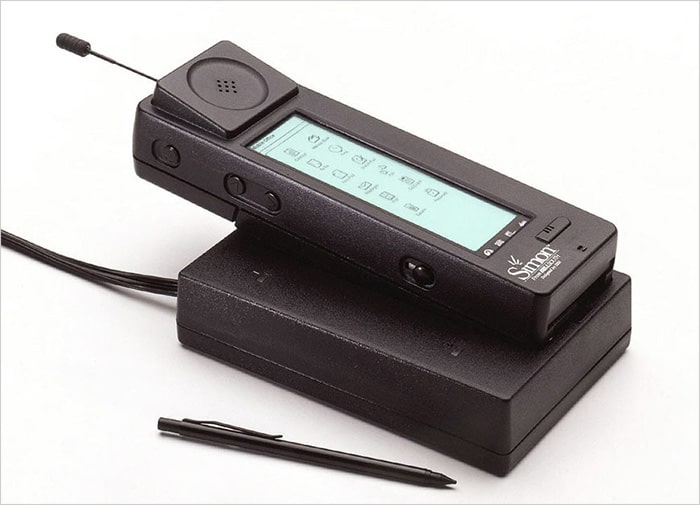
История изобретения телефона была прогрессивной – уже на то время в него удалось внедрить поддержку электронной почты, функции органайзера, несколько игр и даже сенсорный экран! Но весил такой смартфон целый килограмм, а поэтому большой популярности не приобрел. Сам же термин «смартфон» появляется в 2000 году – именно так свою модель умного телефона называла компания Ericsson. Какие появились первые телефоны с умной операционной системой, мало кто помнит, ведь развивались и улучшались они очень быстро.
Перспективы развития
История телефона, по мнению экспертов, в ближайшее время вряд ли будет слишком уж динамичной и, скорее всего, смартфоны мало будут изменяться во внешнем виде. Но это не помешает им уже в ближайшее время выдавить с рынка другую технику, например, фотоаппараты, которые в последнее время активно теряют популярность.
Очевидно, что в дальнейшем история телефона, кратко говоря, будет нацелена на улучшение его функционала, а не формы. В частности, смартфоны будут призваны заменить портативный компьютер и с этой целью будет увеличиваться количество памяти, скорость передачи данных и т.д.
С другой стороны, телефон попытается еще больше увеличить зависимость человека от этого устройства, например, полностью вытеснит банковские карты. Не будем забывать и о разработках в сторону интернета вещей – смартфон в этом будет играть не последнюю роль. Таким образом, история создания телефона не заканчивается, а находится в самом разгаре своего развития, и мы можем лично за ней наблюдать.
Тарас С.Частный инвестор, предприниматель, блогер. Инвестирую с 2008 года. Зарабатываю в интернете на высокодоходных проектах, криптовалютах, IPO, акциях и других активах. Со-владелец нескольких ресторанов и сети магазинов электронной техники. Консультирую партнеров, делюсь опытом.
Присоединяйся в Telegram-канал блога со свежими новостями.
Чат с консультантом в Телеграм.
У меня зазвонил телефон. Кто говорит? Слон! Телефон — изобретение, изменившее мир. Раз уж вся наша современная деятельность так завязана на этой штуке, мы решили проследить историю ее развития, а заодно и понять, как она работает.
Знаете человека, у которого нет телефона? Пожалуй, это разве что очень старые бабушки и дедушки. Ну или ребята из племени Тумба-Юмба. Хотя и у них, наверное, уже есть. Телефон появился полтора века назад, и вот результат: каждый человек звонит по телефону примерно 1500 раз в год!
На нашем телеграм-канале вы найдете много полезной и интересной информации для учащихся.
Изобретение телефона
Что было до телефона? Телеграф с азбукой Морзе. А до телеграфа была почта с почтовыми голубями и лошадьми, сигнальные костры, выстрелы ружей, глашатаи и прочие достаточно примитивные способы связи.
В 17 веке итальянский изобретатель Джованни делла Порта предложил создать систему связи из труб, проложенных по всей стране. Его предложение не оценили по достоинству.
Большинство людей скажет, что телефон изобрел Александр Белл.
На самом деле, в этом вопросе все не так просто. Тут дело обстоит примерно как с радио. О том, кто изобрел телефон первым, можно поспорить.
Сейчас истинным изобретателем телефона считается Антонио Меуччи. Именно он изображен на фото ниже. Из-за нехватки средств изобретатель не сумел отстоять свои права при жизни, и его право на изобретение телефона было признано только 11 июня 2002 года в резолюции № 269 Конгресса США.
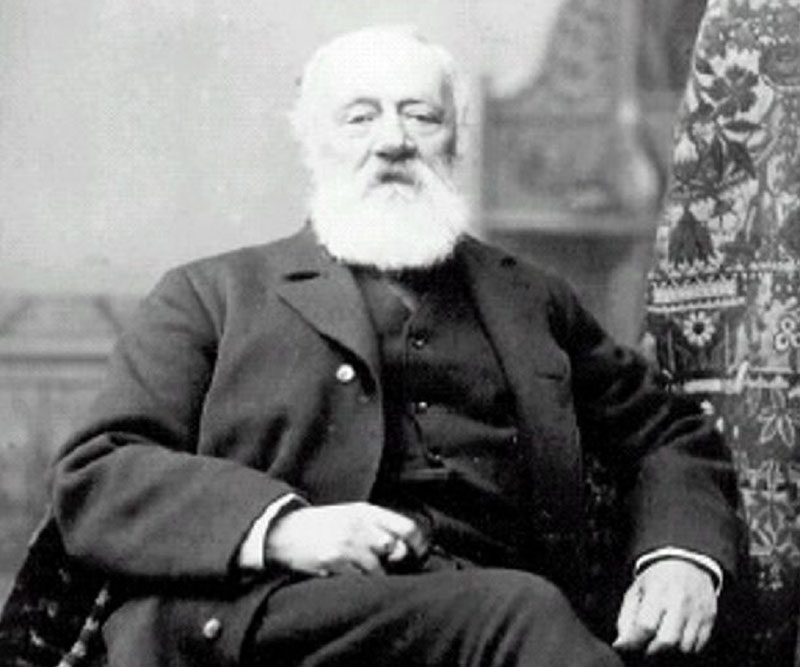
Белл первым запатентовал телефон в 1876 году. Сам изобретатель называл свое устройство “говорящим телеграфом”. На два часа позже Белла в патентное бюро с подобным изобретением обратился Элиш Грэй. Впоследствии между ними была длительная судебная тяжба, которая закончилась победой Белла.
Первый телефонный звонок
В 1876 году состоялся первый телефонный разговор. Всего за 15 лет до этого отменили крепостное право, а люди уже звонили по телефону!
Наверное, этот звонок был связан со многими техническими трудностями, зато точно известно одно: ошибиться номером было нельзя.
Александр Белл позвонил своему помощнику Ватсону, сказав ему: «Ватсон, говорит Белл! Если вы меня слышите, то подойдите к окну и помашите шляпой».
Кстати, к развитию телефона приложил руку и Томас Эдисон. Именно он придумал начинать разговор с «алло».
«Алло» — это не что иное, как “hello”. Алло – международное слово, но в некоторых странах люди традиционно начинают разговор с другого приветствия. Например, в Италии говорят «Pronto», что значит «готов».
Помимо этого, Эдисон предложил использовать микрофон с угольным порошком. Такие микрофоны практически без изменений устанавливались в домашние телефоны с дисковым номеронабирателем вплоть до 1990-х годов.
Кстати! Для всех наших читателей сейчас действует скидка 10% на любой вид работы.
Развитие телефонии
Первые телефоны имели дальность действия всего в 500 метров, у них не было звонка, и вызов приходилось осуществлять с помощью свистка. После внедрения в телефон угольного микрофона и индукционной катушки дальность действия устройства значительно увеличилась.
Первые телефонные станции не могли соединить абонентов напрямую. Для того чтобы «позвонить», нужно было снять трубку и начать крутить рычаг. После соединения с телефонисткой ей говорили номер абонента, она втыкала штекер в гнездо, и только после этого начинался разговор.
Звонить напрямую стало возможно с 20-х годов прошлого века, хотя автоматический коммутатор, способный заменить труд телефонисток, еще в 1887 году предложил русский ученый К.А. Мостицкий .
Это сейчас мы привыкли к 7-ми значным номерам и международным телефонным кодам. А первые телефонные номера состояли всего из 2-3 цифр.
В 1927 году уже можно было позвонить из Нью-Йорка в Лондон. Телефонные сети стали активно покрывать земной шар.
Кстати, звоните нам в любое время! Для наших читателей сейчас действует скидка 10% на любой вид работы
Принцип действия телефона «на пальцах»
Почему на пальцах? Потому что перед тем, как разбираться с чем-то сложным (например, принципом работы современного мобильника), всегда нужно разобраться с простейшими вещами, от которых все и пошло.
Сигналы в телефоне электрические. Человеческая речь — звуковой сигнал. Телефон преобразует звуковые сигналы в электрические и наоборот.
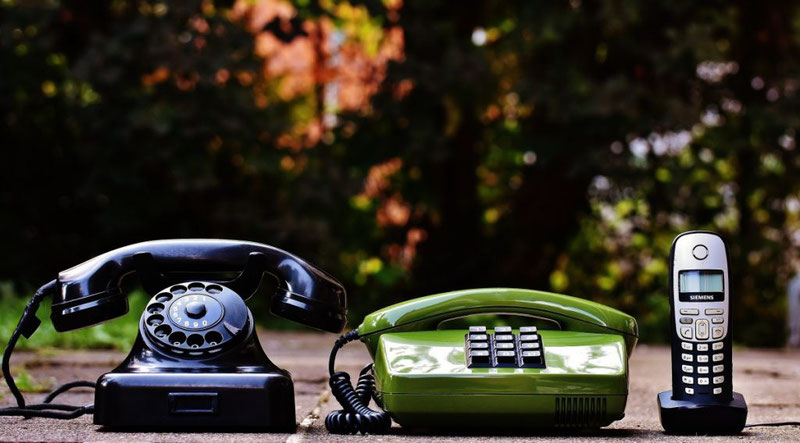
Мы говорим в микрофон, мембрана колеблется, ее колебания в магнитном поле создают ток в катушке, который и передается по проводу к собеседнику. На том конце происходит обратный процесс: ток течет в подвижной катушке динамика, из-за этого мембрана колеблется и «колышет» воздух. В результате мы слышим звук.
Сейчас телефоны можно разделить на:
- обычные стационарные телефоны;
- радиотелефоны;
- сотовые телефоны;
- спутниковые телефоны;
- телефоны, работающие в IP-телефонии.
Появление современных телефонов, мобильная связь
Значение изобретения мобильного телефона также было революционно. А появились первые мобильные в 1976 году. Они были огромными, и стоимость их также была огромной. В 1980-х в Америке уже можно было купить мобильный телефон за 3500 долларов. Для сравнения: новый форд мустанг стоил 6500.
Считается, что его изобрели в США, но есть версия, что первый прототип мобильного был разработан в СССР в 1973 году. Как и многие интересные разработки, советский мобильник остался неизвестен миру.
В странах СНГ мобильные телефоны широко распространились в 90-е годы 20 века.
Перспективы развития телефонов
Ученые, футурологи и социальные исследователи считают, что в будущем смартфоны с большой вероятностью вытеснят такие отдельные устройства, как компьютер, ноутбук и фотоаппарат. Возможности и мощности телефонов позволят просто подключать к ним монитор и клавиатуру, превращая смартфон в полноценный персональный ПК.
Уже сейчас современный телефон представляет собой настоящую исследовательскую станцию, которая собирает огромное количество данных. В будущем количество и качество данных будет расти. Собранная информация может быть использована для самых разных исследований: от поведения групп людей до предсказания землетрясений и прогноза погоды. Банковские карточки также уйдут в прошлое. Уже сейчас есть технология, которая позволяет расплачиваться с помощью смартфона, используя его вместо карточки.
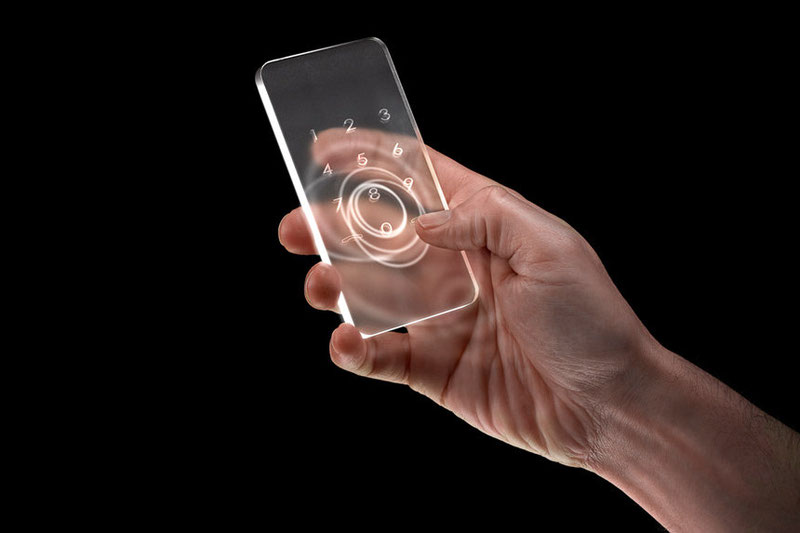
Но это все в будущем. Пока что, каким бы умным ни был смартфон, он не сможет написать курсовую или контрольную за вас. Помочь в этом может специальный студенческий сервис, предоставляющий услуги профессионалов всех областей: от агрономии и бухгалтерского учета до электроники и ядерной физики.

Хотя Александра Грейама Белла обычно приписывают за изобретение телефона, это стало кульминацией исследований, проведенных многими людьми. Антонио Меуччи, Иоганн Филипп Рейс, Инноченцо Манцетти и Элиша Грей внесли важный вклад в изобретение телефона.
Концепция телефона восходит к 1664 году, когда британский физик и эрудит Роберт Гук придумал струнный телефон (также называемый «телефон влюбленных»), состоящий из двух диафрагм, соединенных тугой проволокой или струной. Однако первый практический телефон появился на свет лишь в середине 19 века.
Приписывание истинного изобретателя к конкретному изобретению может быть сложным делом. В большинстве случаев заслуга принадлежит изобретателю самого лучшего рабочего или наиболее практичного прототипа, а не оригинальному изобретателю. Изобретение телефона является одним из таких случаев.
Как правило, Александру Грейаму Беллу приписывают изобретение телефона, но это была кульминация исследований и экспериментов, проведенных многими людьми.
Экспериментальные работы и «передача голоса по проводу», проведенные несколькими изобретателями и многочисленными компаниями, привели к серии судебных исков, связанных с патентными претензиями. По сей день возникают новые противоречия по этому вопросу.
Чтобы объяснить полную историю, мы упомянули 7 ключевых изобретателей, чей вклад привел к изобретению телефона.
Антонио Меуччи
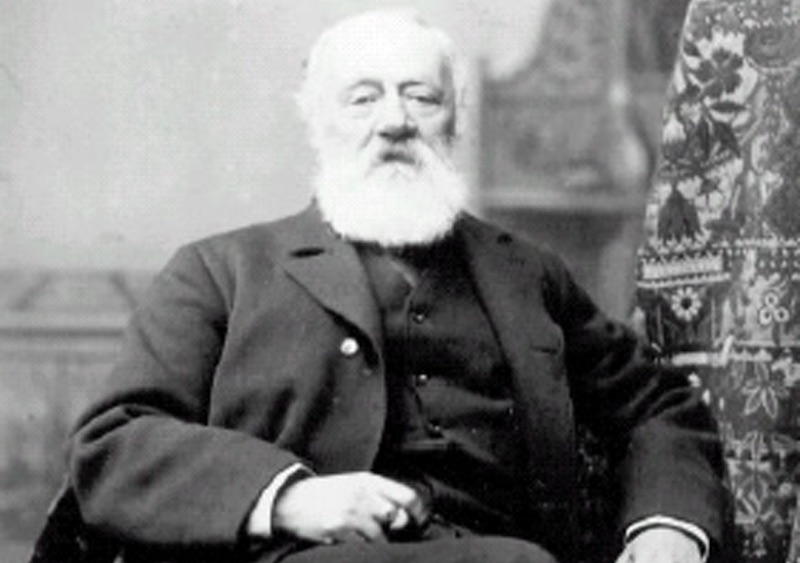
Построил устройство ранней голосовой связи в 1854 году.
Антонио Меуччи наиболее известен за разработку телефоноподобных устройств. В 1854 году он изобрел раннее устройство голосовой связи, названное телетрофоно (telettrofono).
Он утверждал, что построил парный электромагнитный приемник и передатчик, хотя это не было упомянуто в его патентной оговорке 1871 года (уведомление о намерении изобретать; не официальная патентная заявка).
Заслуга в раннем изобретении индуктивной нагрузки телефонных проводов (для усиления сигналов на дальние расстояния) была отдана Меуччи. Но из-за слабых деловых способностей и из-за отсутствия знание английского языка он не смог коммерциализировать свое изобретение в Америке.
В 2002 году Палата представителей США наградила Меуччи за его вклад «в» изобретение телефона (а не «за» изобретение телефона). Они приняли резолюцию, в которой говорится —
«если бы Меуччи смог заплатить 10 долларов за сохранение оговорки после 1874 года, Беллу не удалось бы выдать патент».
В 2008 году Министерство культурного наследия и деятельности Италии отметило 200-летний юбилей Меуччи, назвав его «Inventore del telefono» (изобретатель телефона).
Иоганн Филипп Рейс
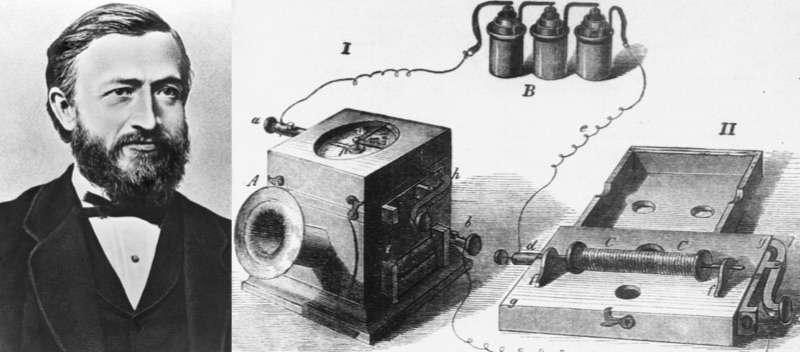
Построил первый телефон в 1861 году.
Иоганн Филипп Рейс, немецкий ученый-самоучка, построил в 1861 году первый речевой передающий телефон, который теперь известен как телефон Рейса.
Он придумал термин «телефон» для описания своего устройства. Он улавливает звук, преобразует его в электрические импульсы и передает эти импульсы по электрическим проводам на другое устройство, которое преобразует импульсы в распознаваемые человеком звуки.
Чтобы доказать, что устройство может передавать акустические звуки на большие расстояния, Рейс послал трудную для понимания немецкую фразу «Das Pferd frisst keinen Gurkensalat» (Лошадь не ест салат из огурцов).
Британская телефонная компания Standard Telephones and Cables позже обнаружила, что устройство Рейса, построенное в начале 1860-х годов, было способно передавать и воспроизводить речь хорошего качества, но с низкой эффективностью.
Филипп Рейс умер в 1874 году, а четыре года спустя европейские исследователи посвятили ему памятник как изобретателю телефона.
Инноченцо Манцетти

Сообщалось, что он изобрел говорящий телеграф в 1864 году.
Инноченцо Манцетти впервые представил идею «говорящего телеграфа» в 1843 году. Однако он не придумал ни одного рабочего прототипа до 1864 года.
В 1865 году он построил электрический телефон, который мог воспроизводить громкоговорящие гласные и музыку с хорошим качеством. Однако он не был ни запатентован, ни представлен ни на одной конференции самим Манцетти.
Хотя парижская газета «Le Petit Journal» описала устройство в краткой статье, в то время не было никаких исторических записей о британских компаниях, внедрявших телефон Манцетти ни в одном регионе.
Элиша Грей

Разработал телефон с помощью водяного микрофона в 1876 году.
Элиша Грей был американским инженером-электриком. Он был наиболее известен за разработку прототипа телефона, который использовал металлический стержень, погруженный в кислотную смесь (или любой другой жидкий проводник).
Электрическое сопротивление можно контролировать, изменяя пропорцию стержня, погруженного в смесь. Это позволило Грею изменить ток, проходящий через инструмент и на приемник.
14 февраля 1876 года адвокат Грея, подал патентную заявку в патентное ведомство США. И это оказалось одним из самых противоречивых патентов в истории. Некоторые авторы утверждают, что Александр Грейам Белл украл идею жидкого передатчика у Элиши Грея.
Александр Грейам Белл
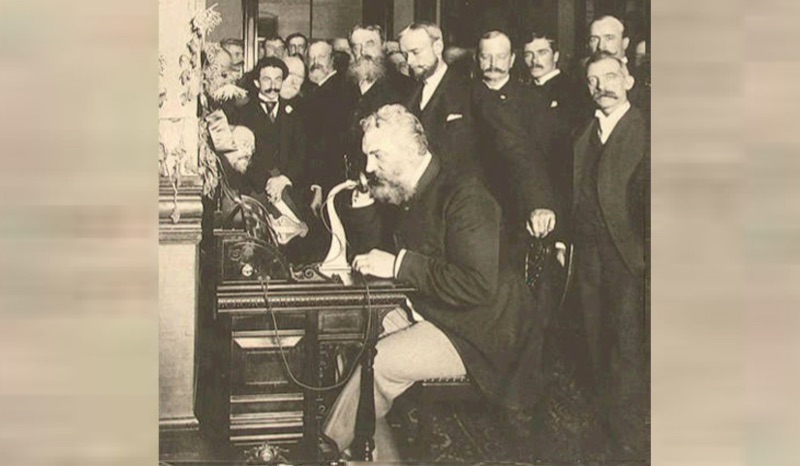
Награжден первым патентом США за изобретение практического телефона в 1876 году.
Эксперименты Александра Грейама Белла со слуховыми аппаратами в конце концов привели к тому, что он получил первый патент на телефон 7 марта 1876 года. Он получил американский патент 174 465 на устройство, которое передает голосовые или другие звуки телеграфным способом.
Через три дня после утверждения патента Белл использовал этот аппарат в Бостоне, чтобы позвонить своему помощнику, который находился в другой комнате. Он сказал: «Мистер Ватсон, идите сюда. Я хочу вас видеть». Через несколько мгновений Ватсон появился рядом с ним и подтвердил, что изобретение сработало.
И Грейам Белл, и Элиша Грей подали независимые заявки в патентное ведомство в Вашингтоне 14 февраля 1876 года. Белл подал заявку на патент телефона, в то время как Грей подал заявку на оговорку телефона.
Эти господа фактически не посещали патентное бюро, их адвокаты делали это от их имени. В некоторых сообщениях говорится, что адвокат Белла прибыл в патентное ведомство раньше, чем адвокат Грэя. Он был пятой записью того дня, а адвокат Грея — 39-м. Таким образом, первый патент на телефон был вручен Грейаму Беллу.
После того как Белл получил патент, он испытал конструкцию жидкостного передатчика Грея, но только в качестве доказательства концептуального эксперимента. Он хотел посмотреть, можно ли электрически передавать членораздельную речь.
Но так как жидкостный передатчик не был пригоден для коммерческих устройств, Белл позже сосредоточился на разработке более совершенных электромагнитных телефонов. После марта 1876 года он никогда не использовал дизайн передатчика Грея в коммерческих продуктах или на публичных демонстрациях.
Томас Эдисон
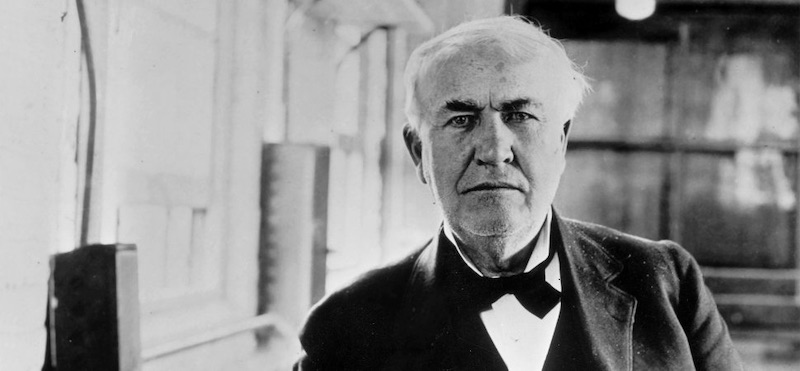
Изобретен углеродный микрофон для получения сильного телефонного сигнала
В 1876 году Томас Алва Эдисон разработал углеродный микрофон для усовершенствования передатчиков, разработанных Грейамом Беллом и Филиппом Рейсом.
Он содержал две металлические пластины, изолированные углеродными гранулами. Эти гранулы изменяют сопротивление в зависимости от давления звуковых волн. Когда постоянный ток проходит между пластинами через гранулы, варьирующееся сопротивление создает переменный ток, который в дальнейшем производит варьируемое давление звуковой волны.
Поскольку углеродные микрофоны могли генерировать аудиосигналы высокого уровня с очень низким напряжением постоянного тока, без какого-либо дополнительного усиления, они широко использовались в телефонах вместе с приемником Bell с 1890 до 1980-х годов.
По словам Эдисона,
Первым изобретателем телефона был Филипп Рейс, но его устройство могло передавать только музыку (не речь). Первым, кто публично продемонстрировал телефон для передачи красноречивой речи, был Грейам Белл.
Первый коммерческий телефон (который мог передавать разборчивую речь) был изобретен только им. Его изобретение используется для передачи, в то время как Белл используется для получения.
Тивадар Пушкаш
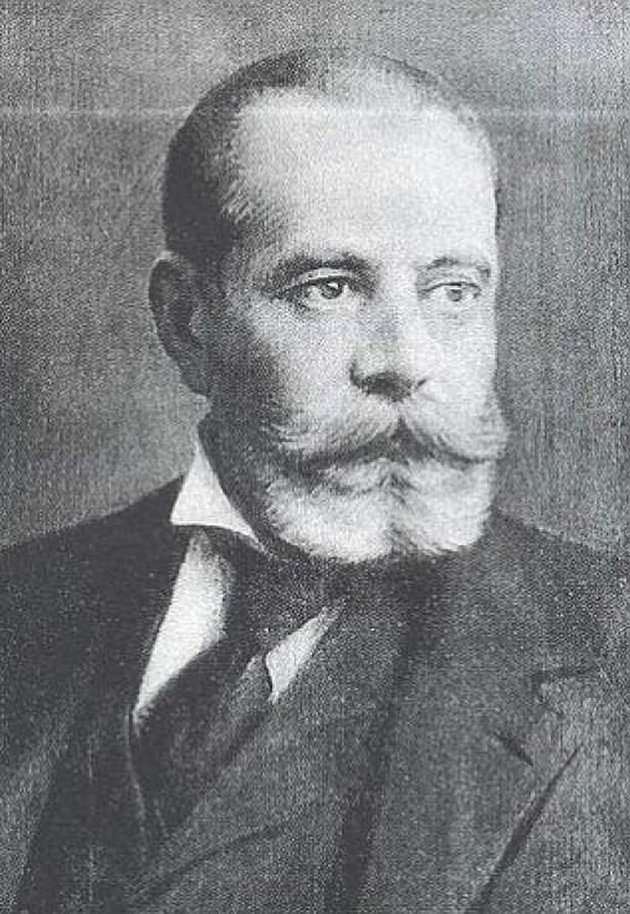
Предложил телефонную коммутаторную станцию в 1876 году.
Тивадар Пушкас работал над своей идеей электрической телеграфной станции, когда Грейам Белл получил первый патент на телефон. Это заставило Пушкаса пересмотреть свою работу.
Он связался с Томасом Эдисоном и начал заниматься совершенствованием своей схемы развития телефонной станции. По словам Эдисона, Пушкас первым пришел с идеей создания телефонной станции.
Первая экспериментальная телефонная станция, основанная на идее Пушкаша, была построена компанией Bell Telephone Company в Бостоне в 1877 году. Спустя десятилетие он представил мультиплексный коммутатор, который ускорил развитие телефонной станции.
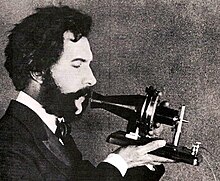
Actor portraying Alexander Graham Bell in a 1926 silent film. Shows Bell’s first telephone transmitter (microphone), invented 1876 and first displayed at the Centennial Exposition, Philadelphia.
This history of the telephone chronicles the development of the electrical telephone, and includes a brief overview of its predecessors. The first telephone patent was granted to Alexander Graham Bell in 1876.
Mechanical and acoustic devices[edit]

A 19th century acoustic tin can or «lovers’ telephone»
Before the invention of electromagnetic telephones, mechanical acoustic devices existed for transmitting speech and music over a greater distance. This distance was greater than that of normal direct speech. The earliest mechanical telephones were based on sound transmission through pipes or other physical media.[1] The acoustic tin can telephone, or «lovers’ phone», has been known for centuries.[1] It connects two diaphragms with a taut string or wire, which transmits sound by mechanical vibrations from one to the other along the wire (and not by a modulated electric current). The classic example is the children’s toy made by connecting the bottoms of two paper cups, metal cans, or plastic bottles with tautly held string.[1][2]
Some of the earliest known experiments were conducted by the British physicist and polymath, Robert Hooke, from 1664 to 1685.[1][3] An acoustic string phone made in 1667 has been attributed to him.[4] An early version was also found in use by the Chimu in Peru. The gourd and stretched-hide version resides in the Smithsonian Museum collection and dates back to around the 7th century AD.[5]
For a few years in the late 1800s, acoustic telephones were marketed commercially as a competitor to the electrical telephone. When the Bell telephone patents expired and many new telephone manufacturers began competing, acoustic telephone makers quickly went out of business. Their maximum range was very limited.[2] An example of one such company was the Pulsion Telephone Supply Company created by Lemuel Mellett in Massachusetts, which designed its version in 1888 and deployed it on railroad right-of-ways.
Additionally, speaking tubes have long been common, especially within buildings and aboard ships, and they are still in use today.[6]
Electrical devices[edit]
The telephone emerged from the making and successive improvements of the electrical telegraph. In 1804, Spanish polymath and scientist Francisco Salva Campillo constructed an electrochemical telegraph.[7] The first working telegraph was built by the English inventor Francis Ronalds in 1816 and used static electricity.[8] An electromagnetic telegraph was created by Baron Schilling in 1832. Carl Friedrich Gauss and Wilhelm Weber built another electromagnetic telegraph in 1833 in Göttingen. At the University of Gottingen, the two had been working together in the field of magnetism. They built the first telegraph to connect the observatory and the Institute of physics, which was able to send eight words per minute.[9]

Bell prototype telephone stamp
Centennial Issue of 1976
The electrical telegraph was first commercialized by Sir William Fothergill Cooke and entered use on the Great Western Railway in England. It ran for 13 mi (21 km) from Paddington station to West Drayton and came into operation on April 9, 1839.
Another electrical telegraph was independently developed and patented in the United States in 1837 by Samuel Morse. His assistant, Alfred Vail, developed the Morse code signaling alphabet with Morse. America’s first telegraph was sent by Morse on January 6, 1838, across 2 miles (3 km) of wiring.
Invention of the telephone[edit]
Credit for the invention of the electric telephone is frequently disputed, and new controversies over the issue have arisen from time to time. Antonio Meucci, Alexander Graham Bell, and Elisha Gray amongst others, have all been credited with the telephone’s invention. The early history of the telephone became and still remains a confusing morass of claims and counterclaims, which were not clarified by the huge number of lawsuits filed in order to resolve the patent claims of the many individuals and commercial competitors. The Bell and Edison patents, however, were commercially decisive, because they dominated telephone technology and were upheld by court decisions in the United States.
-

Philipp Reis, 1861, constructed the first telephone, today called the Reis telephone.
-


The master telephone patent granted to Bell, 174465, March 10, 1876
The modern telephone is the result of the work of many people.[10] Alexander Graham Bell was, however, the first to patent the telephone, as an «apparatus for transmitting vocal or other sounds telegraphically». Bell has most often been credited as the inventor of the first practical telephone. Johann Philipp Reis coined the term «telephon».[11] Models of it were sent abroad, to London, Dublin, Tiflis, and other places. It became a subject for popular lectures, and an article for scientific cabinets. Edison credited him as the «first inventor of the telephone.»[12]
The Italian-American inventor and businessman Antonio Meucci has been recognized by the U.S. House of Representatives for his contributory work on the telephone.[13] Several other controversies also surround the question of priority of invention for the telephone.
The Elisha Gray and Alexander Bell telephone controversy considers the question of whether Bell and Gray invented the telephone independently and, if not, whether Bell stole the invention from Gray. This controversy is narrower than the broader question of who deserves credit for inventing the telephone, for which there are several claimants.
The Canadian Parliamentary Motion on Alexander Graham Bell article reviews the controversial June 2002 United States House of Representatives resolution recognizing Meucci’s contributions ‘in’ the invention of the telephone (not ‘for’ the invention of the telephone). The same resolution was not passed in the U.S. Senate, thus labeling the House resolution as «political rhetoric». A subsequent counter-motion was unanimously passed in Canada’s Parliament 10 days later which declared Bell its inventor. This webpage examines critical aspects of both the parliamentary motion and the congressional resolution.
Telephone exchange[edit]
The main users of the electrical telegraph were post offices, railway stations, the more important governmental centers (ministries), stock exchanges, very few nationally distributed newspapers, the largest internationally important corporations, and wealthy individuals.[14]
Telegraph exchanges worked mainly on a store and forward basis. Although telephones devices were in use before the invention of the telephone exchange, their success and economical operation would have been impossible with the schema and structure of the contemporary telegraph systems.
Prior to the invention of the telephone switchboard, pairs of telephones were connected directly with each other, which was primarily useful for connecting a home to the owner’s business (They practically functioned as a primitive intercom).[15] A telephone exchange provides telephone service for a small area. Either manually by operators, or automatically by machine switching equipment, it interconnects individual subscriber lines for calls made between them. This made it possible for subscribers to call each other at homes, businesses, or public spaces. These made telephones an available and comfortable communication tool for many purposes, and it gave the impetus for the creation of a new industrial sector.
The telephone exchange was an idea of the Hungarian engineer Tivadar Puskás (1844–1893) in 1876, while he was working for Thomas Edison on a telegraph exchange.[16][17][18][19][20] The first commercial telephone exchange was opened at New Haven, Connecticut, with 21 subscribers on 28 January 1878,[21] in a storefront of the Boardman Building in New Haven, Connecticut. George W. Coy designed and built the world’s first switchboard for commercial use. Coy was inspired by Alexander Graham Bell’s lecture at the Skiff Opera House in New Haven on 27 April 1877.[21]
In Bell’s lecture, during which a three-way telephone connection with Hartford and Middletown, Connecticut, was demonstrated, he first discussed the idea of a telephone exchange for the conduct of business and trade. On 3 November 1877, Coy applied for and received a franchise from the Bell Telephone Company for New Haven and Middlesex Counties. Coy, along with Herrick P. Frost and Walter Lewis, who provided the capital, established the District Telephone Company of New Haven on 15 January 1878.[21]
The switchboard built by Coy was, according to one source, constructed of «carriage bolts, handles from teapot lids and bustle wire.» According to the company records, all the furnishings of the office, including the switchboard, were worth less than forty dollars. While the switchboard could connect as many as sixty-four customers, only two conversations could be handled simultaneously and six connections had to be made for each call.[21]
The District Telephone Company of New Haven went into operation with only twenty-one subscribers, who paid $1.50 per month. By 21 February 1878, however, when the first telephone directory was published by the company, fifty subscribers were listed. Most of these were businesses and listings such as physicians, the police, and the post office; only eleven residences were listed, four of which were for persons associated with the company.[21]
The New Haven District Telephone Company grew quickly and was reorganized several times in its first years. By 1880, the company had the right from the Bell Telephone Company to service all of Connecticut and western Massachusetts. As it expanded, the company was first renamed Connecticut Telephone, and then Southern New England Telephone in 1882.[21] The site of the first telephone exchange was granted a designation as a National Historic Landmark on 23 April 1965. However it was withdrawn in 1973 in order to demolish the building and construct a parking garage.[21]
Early telephone developments[edit]
The following is a brief summary of the history of the development of the telephone:
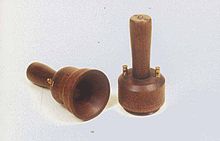

- Early 7th century AD — Chimu culture in Peru invents a string telephone using gourds and stretched hide. The original artifact is in the Smithsonian’s National Museum of the American Indian storage facility in Suitland, Maryland.
- 1667: Robert Hooke invents a string telephone that conveys sounds over an extended wire by mechanical vibrations. It was to be termed an ‘acoustic’ or ‘mechanical’ (non-electrical) telephone.
- 1753: Charles Morrison proposes the idea that electricity can be used to transmit messages, by using different wires for each letter.[22]
- 1844: Innocenzo Manzetti first moots the idea of a «speaking telegraph» (telephone).
- 1854: Charles Bourseul writes a memorandum on the principles of the telephone. (See the article: «Transmission électrique de la parole», L’Illustration, Paris, 26 August 1854.)
- 1854: Antonio Meucci demonstrates an electric voice-operated device in New York; exactly what kind of device he demonstrates is unknown.
- 1861: Philipp Reis constructs the first speech-transmitting telephone
- 28 December 1871: Antonio Meucci files a patent caveat (No. 3353, a notice of intent to invent, but not a formal patent application) at the U.S. Patent Office for a device he names a «Sound Telegraph».[23]
- 1872: Elisha Gray establishes Western Electric Manufacturing Company.
- 1 July 1875: Bell uses a bi-directional «gallows» telephone that is able to transmit «voicelike sounds», but not clear speech. Both the transmitter and the receiver are identical membrane electromagnet instruments.
- 1875: Thomas Edison experiments with acoustic telegraphy and in November builds an electro-dynamic receiver, but does not exploit it.
- 1875: Hungarian Tivadar Puskás (the inventor of the telephone exchange) arrives in the USA.
- 6 April 1875: Bell’s U.S. Patent 161,739 «Transmitters and Receivers for Electric Telegraphs» is granted. This uses multiple vibrating steel reeds in make-break circuits, and the concept of multiplexed frequencies.
- 20 January 1876: Bell signs and notarizes his patent application for the telephone.
- 11 February 1876: Elisha Gray designs a liquid transmitter for use with a telephone, but does not build one.
- 7 March 1876: Bell’s U.S. patent No. 174,465 for the telephone is granted.
- 10 March 1876: Bell transmits the sentence: «Mr. Watson, come here! I want to see you!» using a liquid transmitter and an electromagnetic receiver.
- 10 August 1876: Using the telegraph line between Brantford and Paris, Ontario, eight miles (thirteen kilometres) distant, Bell makes a telephone call, said by some to be the «world’s first long-distance call».[24]
- 30 January 1877: Bell’s U.S. patent No. 186,787 is granted for an electromagnetic telephone using permanent magnets, iron diaphragms, and a call bell.
- 27 April 1877: Edison files for a patent on a carbon (graphite) transmitter. Patent No. 474,230 is granted on 3 May 1892, after a 15-year delay because of litigation. Edison is later granted patent No. 222,390 for a carbon granules transmitter in 1879.
- 6 October 1877: Scientific American publishes the invention from Bell—at that time still without a ringer.
- 25 October 1877: the article in Scientific American is discussed at the Telegraphenamt in Berlin
- 12 November 1877: The first commercial telephone company enters telephone business in Friedrichsberg close to Berlin[25] using the Siemens pipe as ringer and telephone devices built by Siemens.
- 1877: The first experimental Telephone Exchange is established in Boston.
- 1877: First long-distance telephone line
- 1877: Emile Berliner invents the telephone transmitter.
- 14 January 1878: Bell demonstrates the telephone to Queen Victoria and makes the first publicly-witnessed long-distance calls in the UK. The queen tries the device and finds it to be «quite extraordinary».[26]
- 26 January 1878: The first permanent telephone connection in the UK is made between two businesses in Manchester
- 28 January 1878: The first commercial US telephone exchange opens in New Haven, Connecticut.
- 15 June 1878: The first commercial toll line enters operation, connecting Springfield and Holyoke, Massachusetts[27]
- 1887: Tivadar Puskás introduces the multiplex switchboard, that has an epochal significance in the further development of telephone exchanges.[28]
- 1915: The first U.S. coast-to-coast long-distance telephone call, is ceremonially inaugurated by A.G. Bell in New York City and his former assistant Thomas Augustus Watson in San Francisco, California.
- 1927: The first transatlantic phone call is made, from the United States to the United Kingdom.[29]
Early commercial instruments[edit]

1917 wall telephone, open to show magneto and local battery
Early telephones were technically diverse. Some of them used liquid transmitters which soon went out of use. Others were dynamic: their diaphragms vibrated a coil of wire in the field of a permanent magnet or vice versa. Such sound-powered telephones survived in small numbers through the 20th century in military and maritime applications where the ability to create its own electrical power was crucial. Most, however, used Edison/Berliner carbon transmitters, which were much louder than the other kinds, even though they required induction coils, actually acting as impedance matching transformers to make it compatible to the line impedance. The Edison patents kept the Bell monopoly viable into the 20th century, by which time telephone networks were more important than the instrument.
Early telephones were locally powered by a dynamic transmitter. One of the jobs of outside plant personnel was to visit each telephone periodically to inspect the battery. During the 20th century, the «common battery» operation came to dominate, and was powered by the «talk battery» from the telephone exchange over the same wires that carried the voice signals. Late in the century, wireless handsets brought a revival of local battery power.
The earliest telephones had only one wire for transmitting and receiving of audio, and used a ground return path. The earliest dynamic telephones also had only one opening for sound, and the user listened and spoke into the same hole. Sometimes the instruments were operated in pairs at each end, making conversation more convenient but also more expensive.

Historical marker commemorating the first telephone central office in New York State (1878)
At first, telephones were leased in pairs to the subscriber, for example one for his home and one for his shop, and the subscriber had to arrange with telegraph contractors to construct a line between them. Users who wanted the ability to speak to three or four different shops, suppliers etc. would obtain and set up three or four pairs of telephones. Western Union, already using telegraph exchanges, quickly extended the principle to its telephones in New York City and San Francisco, and Bell was not slow in appreciating the potential.
Signaling began in an appropriately primitive manner. The user alerted the other end, or the exchange operator, by whistling into the transmitter. Exchange operation soon resulted in telephones being equipped with a bell, first operated over a second wire and later with the same wire using a condenser. Telephones connected to the earliest Strowger automatic exchanges had seven wires, one for the knife switch, one for each telegraph key, one for the bell, one for the push button and two for speaking.
Rural and other telephones that were not on a common battery exchange had hand cranked «magneto» generators to produce an alternating current to ring the bells of other telephones on the line and to alert the exchange operator.
In 1877 and 1878, Edison invented and developed the carbon microphone used in all telephones along with the Bell receiver until the 1980s. After protracted patent litigation, a federal court ruled in 1892 that Edison and not Emile Berliner was the inventor of the carbon microphone. The carbon microphone was also used in radio broadcasting and public address work through the 1920s.
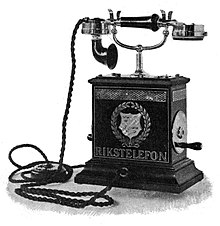
In the 1890s a new smaller style of telephone was introduced, the candlestick telephone, and it was packaged in three parts. The transmitter stood on a stand, known as a «candlestick» for its shape. When not in use, the receiver hung on a hook with a switch in it, known as a «switchhook.» Previous telephones required the user to operate a separate switch to connect either the voice or the bell. With the new kind, the user was less likely to leave the phone «off the hook». In phones connected to magneto exchanges, the bell, induction coil, battery, and magneto were in a separate bell box called a «ringer box.» In phones connected to common battery exchanges, the ringer box was installed under a desk, or other out of the way place, since it did not need a battery or magneto.
Cradle designs were also used at this time, with a handle with the receiver and transmitter attached, separate from the cradle base that housed the magneto crank and other parts. They were larger than the «candlestick» and more popular.
Disadvantages of single-wire operation, such as crosstalk and hum from nearby AC power wires, had already led to the use of twisted pairs and, for long-distance telephones, four-wire circuits. Users at the beginning of the 20th century did not place long-distance calls from their own telephones but made an appointment to use a special sound-proofed long-distance telephone booth furnished with the latest technology.
Around 1893, the country leading the world in telephones per 100 persons—known as teledensity—was Sweden with 0.55 in the whole country but 4 in Stockholm (10,000 out of a total of 27,658 subscribers).[30] This compares with 0.4 in the US for that year.[31] Telephone service in Sweden developed through a variety of institutional forms: the International Bell Telephone Company (a U.S. multinational), town and village co-operatives, the General Telephone Company of Stockholm (a Swedish private company), and the Swedish Telegraph Department (part of the Swedish government). Since Stockholm consists of islands, telephone service offered relatively large advantages, but had to use submarine cables extensively. Competition between Bell Telephone and General Telephone, and later between General Telephone and the Swedish Telegraph Dept., was intense.
In 1893, the U.S. was considerably behind Sweden, New Zealand, Switzerland, and Norway in teledensity. The U.S. became the world leadership in teledensity with the rise of many independent telephone companies after the Bell patents expired in 1893 and 1894.
20th-century developments[edit]
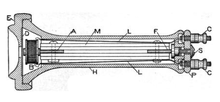
Old Receiver schematic, c.1906


Top of cellular telephone tower
By 1904, over three million phones in the U.S.[32] were connected by manual switchboard exchanges. By 1914, the U.S. was the world leader in telephone density and had more than twice the teledensity of Sweden, New Zealand, Switzerland, and Norway. The relatively good performance of the U.S. occurred despite competing telephone networks not interconnecting.[33] On January 7, 1927, W. S. Gifford, president of the American Telephone & Telegraph Company, called Evelyn P. Murray to test the first commercial telephone line across the Atlantic Ocean.[29]
What turned out to be the most popular and longest-lasting physical style of telephone was introduced in the early 20th century, including Bell’s model 102 telephone. A carbon granule transmitter and electromagnetic receiver were united in a single molded plastic handle, which when not in use were placed in a cradle in the base unit. The circuit diagram[34] of the model 102 shows the direct connection of the receiver to the line, while the transmitter was induction coupled, with energy supplied by a local battery. The coupling transformer, battery, and ringer were in a separate enclosure from the desk set. The rotary dial in the base interrupted the line current by repeatedly but very briefly disconnecting the line 1 to 10 times for each digit, and the hook switch (in the center of the circuit diagram) permanently disconnected the line and the transmitter battery while the handset was on the cradle.
Starting in the 1930s, the base of the telephone also enclosed its bell and induction coil, obviating the need for a separate ringer box. Power was supplied to each subscriber line by central-office batteries instead of the user’s local battery, which required periodic service. For the next half century, the network behind the telephone grew progressively larger and much more efficient, and, after the rotary dial was added, the instrument itself changed little until Touch-Tone signaling started replacing the rotary dial in the 1960s.
The history of mobile phones can be traced back to two-way radios permanently installed in vehicles such as taxicabs, police cruisers, railroad trains, and the like. Later versions such as the so-called transportables or «bag phones» were equipped with a cigarette-lighter plug so that they could also be carried, and thus could be used as either mobile two-way radios or as portable phones by being patched into the telephone network.
In December 1947, Bell Labs engineers Douglas H. Ring and W. Rae Young proposed hexagonal cell transmissions for mobile phones.[35] Philip T. Porter, also of Bell Labs, proposed that the cell towers be at the corners of the hexagons rather than the centers and have directional antennas that would transmit/receive in 3 directions (see picture at right) into 3 adjacent hexagon cells.[36][37] The technology did not exist then and the radio frequencies had not yet been allocated. Cellular technology was undeveloped until the 1960s, when Richard H. Frenkiel and Joel S. Engel of Bell Labs developed the electronics.
Meanwhile, the 1956 inauguration of the TAT-1 cable and later international direct dialing were important steps in putting together the various continental telephone networks into a global network.
On 3 April 1973, Motorola manager Martin Cooper placed a cellular-phone call (in front of reporters) to Dr. Joel S. Engel, head of research at AT&T’s Bell Labs. This began the era of the handheld cellular-mobile phone.
Cable-television companies began to use their fast-developing cable networks with ducting under the streets of the United Kingdom in the late 1980s to provide telephony services in association with major telephone companies. One of the early cable operators in the UK, Cable London, connected its first cable telephone customer in about 1990.
Digital telephone technology[edit]
The rapid development and wide adoption of pulse-code modulation (PCM) digital telephony was enabled by metal–oxide–semiconductor (MOS) technology.[38] The MOS field-effect transistor (MOSFET) was invented by Mohamed M. Atalla and Dawon Kahng at Bell Telephone Laboratories in 1959, and the MOS integrated circuit (MOS IC) chip was proposed soon after, but MOS technology was initially overlooked by Bell because they did not find it practical for analog telephone applications, before it was commercialized by Fairchild and RCA for digital electronics such as computers.[39][38] MOS technology eventually became practical for telephone applications with the MOS mixed-signal integrated circuit, which combines analog and digital signal processing on a single chip, developed by former Bell engineer David A. Hodges with Paul R. Gray at UC Berkeley in the early 1970s.[38] In 1974, Hodges and Gray worked with R.E. Suarez to develop MOS switched capacitor (SC) circuit technology, which they used to develop the digital-to-analog converter (DAC) chip, using MOSFETs and MOS capacitors for data conversion. This was followed by the analog-to-digital converter (ADC) chip, developed by Gray and J. McCreary in 1975.[38]
MOS SC circuits led to the development of PCM codec-filter chips in the late 1970s.[38][40] The silicon-gate CMOS (complementary MOS) PCM codec-filter chip, developed by Hodges and W.C. Black in 1980,[38] has since been the industry standard for digital telephony.[38][40] By the 1990s, telecommunication networks such as the public switched telephone network (PSTN) had been largely digitized with very-large-scale integration (VLSI) CMOS PCM codec-filters, widely used in switching systems for telephone exchanges, private branch exchanges (PBX) and key telephone systems (KTS); user-end modems; data transmission applications such as digital loop carriers, pair gain multiplexers, telephone loop extenders, integrated services digital network (ISDN) terminals, digital cordless telephones and digital cell phones; and applications such as speech recognition equipment, voice data storage, voice mail and digital tapeless answering machines.[40] The bandwidth of digital telecommunication networks has been rapidly increasing at an exponential rate, as observed by Edholm’s law,[41] largely driven by the rapid scaling and miniaturization of MOS technology.[42][38]
The British companies Pye TMC, Marconi-Elliott and GEC developed the digital push-button telephone, based on MOS IC technology, in 1970. It was variously called the «MOS telephone», the «push-button telephone chip», and the «telephone on a chip». It used MOS IC logic, with thousands of MOSFETs on a chip, to convert the keypad input into a pulse signal. This made it possible for push-button telephones to be used with pulse dialing at most telephone exchanges.[43][44] MOS telephone technology introduced a new feature: the use of MOS memory chips to store phone numbers, which could then be used for speed dialing at the push of a button.[43][44][45] This was demonstrated in the United Kingdom by Pye TMC, Marcno-Elliot and GEC in 1970.[43][44] Between 1971 and 1973, Bell combined MOS technology with touch-tone technology to develop a push-button MOS touch-tone phone called the «Touch-O-Matic» telephone, which could store up to 32 phone numbers. This was made possible by the low cost, low power requirements, small size and high reliability of MOSFETs, over 15,000 of which were contained on ten MOS IC chips, including one chip for logic, one for the keypad dial interface, and eight for memory.[46]
Women’s usage in the 20th century[edit]

Private conversation, 1910
The telephone was instrumental to modernization. It aided in the development of suburbs and the separation of homes and businesses, but also became a reason for the separation between women occupying the private sphere and men in the public sphere.[47] Both historically and currently, women are predominantly responsible for the telephone calls that bridge the public and private sphere, such as calls regarding doctor’s appointments and meetings.[48]
21st-century developments[edit]
Internet Protocol (IP) telephony, also known as Internet telephony or Voice over Internet Protocol (VoIP), is a disruptive technology that is rapidly gaining ground against traditional telephone network technologies.

Modern Apple Iphone. This phone is considered a smartphone
IP telephony uses a broadband Internet service to transmit conversations as data packets. In addition to replacing the traditional plain old telephone service (POTS) systems, IP telephony competes with mobile phone networks by offering free or lower cost service via WiFi hotspots. VoIP is also used on private wireless networks which may or may not have a connection to the outside telephone network.
Telecommunication of the 21st century has been dominated by the development of the smartphone. This is a combination of a hand-held computer, a cellular phone, a digital camera, and Internet access. One of its features is the touch screen that facilitates the primary interaction for users for most tasks, such as dialing telephone numbers. Some of its software features also include email communication, as well as audio and video playback and capture.
See also[edit]
- Bell Telephone Memorial, a major monument dedicated to the invention of the telephone
- Carbon microphone
- Charles Bourseul – claimed inventor of the telephone
- Elisha Gray
- Elisha Gray and Alexander Bell telephone controversy
- History of mobile phones
- History of telecommunication
- History of videotelephony
- Innocenzo Manzetti
- Invention of the telephone
- Johann Philipp Reis – claimed inventor of the telephone
- Antonio Meucci – claimed inventor of the telephone
- Private branch exchange
- Push-button telephone
- Telephone exchange
- The Telephone Cases, a series of court decisions in the U.S. on the telephone’s invention
- Thomas Edison’s carbon telephone transmitter – greatly improved the telephone’s sound quality
- Timeline of the telephone
References[edit]
- ^ a b c d McVeigh, Daniel P.
An Early History of the Telephone: 1664-1866: Robert Hooke’s Acoustic Experiments and Silent Inventions Archived 24 May 2014 at the Wayback Machine, Columbia University website. Retrieved 15 January 2013. This work in turn cites:- Richard Waller and edited by R.T. Gunther. «The Postthumous Works of Robert Hooke, M.D., S.R.S. 1705.» Reprinted in R.T. Gunther’s «Early Science In Oxford», Vol. 6, p. 185, 25
- ^ a b Jacobs, Bill. Acoustic Telephones, TelefoonMuseum.com website. Retrieved 15 January 2013. This article in turn cites:
- Kolger, Jon. «Mechanical or String Telephones», ATCA Newsletter, June 1986; and
- «Lancaster, Pennsylvania Agricultural Almanac for the Year 1879: How to Construct a Farmer’s Telephone», John Bater’s Sons.; and
- «Telephone Experiences of Harry J. Curl as told by him to E. T. Mahood, During the summer of 1933 at Kansas City, Missouri: First Telephone Experience.»
- ^ Grigonis, Richard. x +jchdjn$hbdgdveudydcgeenterprise-fixed-communications/articles/47924-telephone-1665.htm A Telephone can 1665?[permanent dead link], TMCNet Technews website, 29 December 2008.
- ^ Giles, Arthur (editor). County Directory of Scotland (for 1901-1904): Twelfth Issue: Telephone (Scottish Post Office Directories), Edinburgh: R. Grant & Son, 1902, p. 28.
- ^ Baldwin, Neil. «There’s a 1,200-year-old Phone in the Smithsonian Collections». smithsonianmag.com. Smithsonian Museum. Retrieved 20 August 2022.
- ^ «Voicepipes and Speaking-Tubes». The Museum of Retro-Technology. 15 March 2010. Retrieved 17 October 2012.
- ^ Jones, R. Victor S Archived 11 October 2012 at the Wayback Machine d» Electrochemical Telegraph (1808-10)], Harvard University website. Attributed to «Semaphore to Satellite», International Telecommunication Union, Geneva 1965. Retrieved 2009-05-01
- ^ Ronalds, B.F. (2016). Sir Francis Ronalds: Father of the Electric Telegraph. London: Imperial College Press. ISBN 978-1-78326-917-4.
- ^ Hentschel, K. (March 1999). «Some Historical Points of Interest in Göttingen». Physics in Perspective. 1 (1): 110–117. Bibcode:1999PhP…..1..110H. doi:10.1007/s000160050009. ISSN 1422-6944. S2CID 119459958.
- ^ Lewis Coe (1995), «The Telephone and Its Several Inventors»
- ^ http://news.bbc.co.uk/2/hi/science/nature/3253174.stm
- ^ Edison, Thomas A. The Edison Papers, Digital Edition Rutgers University, accessed 26 March 2006. LB020312 TAEM 83:170
- ^ «H.Res.269 — Expressing the sense of the House of Representatives to honor the life and achievements of 19th-century Italian-American inventor Antonio Meucci, and his work in the invention of the telephone. 107th Congress (2001-2002)». U.S. House of Representatives. 11 June 2002. Retrieved 7 February 2014.
- ^ Private Telegraphs, The Sydney Morning Herald, credited to The Times, 19 April 1878, p. 6.
- ^ Bo Leuf (2002). Peer to Peer: Collaboration and Sharing Over the Internet. Addison-Wesley. p. 15. ISBN 9780201767322.
- ^ Alvin K. Benson (2010). Inventors and inventions Great lives from history Volume 4 of Great Lives from History: Inventors & Inventions. Salem Press. p. 1298. ISBN 9781587655227.
- ^ Puskás Tivadar (1844 — 1893) (short biography), Hungarian History website. Retrieved from Archive.org, February 2013.
- ^ «Puskás Tivadar (1844 — 1893)». Mszh.hu. Archived from the original on 8 October 2010. Retrieved 1 July 2012.
- ^ «Puskás, Tivadar». Omikk.bme.hu. Retrieved 1 July 2012.
- ^ «Welcome hunreal.com — BlueHost.com». Hunreal.com. Archived from the original on 16 March 2012. Retrieved 1 July 2012.
- ^ a b c d e f g
Withdrawal of National Historic Landmark Designation: Site of the First Telephone Exchange, New Haven, New Haven County, Connecticut, United States National Park Service, United States Department of the Interior, 13 April 2006.Archived 15 August 2012 at the Wayback Machine
- ^ «History Of The Invention Of Telephone». The Reverse Phone. 9 June 2011. Retrieved 22 April 2012.
- ^ «Antonio Meucci — Questions and Answers». Chezbasilio.org. Retrieved 30 August 2012.
- ^ «Alexander Graham Bell 1847-1922 Inventor of the Bell System». Telecommunications Canada. Retrieved 14 January 2020.
- ^ «Cdrtools (Cdrecord) release information».
- ^ «Alexander Graham Bell demonstrates the newly invented telephone». The Telegraph. 13 January 2017. Archived from the original on 12 January 2022. Retrieved 14 January 2020.
- ^ «Southern New England Telephone Company: The First Fifty Years, 1878-1928». Thomas J. Dodd Research Center. University of Connecticut. Archived from the original on 9 June 2008.
- ^ Francis S. Wagner: Hungarian Contributions to World Civilization – Page 68
- ^ a b «First Transatlantic Telephone Call». Retrieved 22 March 2019.
- ^
Bennett, Alfred Roslin (1895). Telephone Systems of the Continent of Europe. p. 337. Retrieved 14 June 2012. - ^
«Early U.S. Telephone Industry Data». Retrieved 15 June 2012. - ^ «AT&T: History: Origins». Corp.att.com. Archived from the original on 20 August 2012. Retrieved 30 August 2012.
- ^ «Leaders in the early spread of telephone service». Purplemotes.net. 21 March 2010.
- ^ «Fig I-102 Type Sidetone Hand Telephone Set Shown with 534Y Subscriber Set». Archived from the original on 16 June 2007. Retrieved 29 May 2007.
- ^ «1947 memo by Douglas H. Ring proposing hexagonal cells» (PDF). Archived from the original (PDF) on 7 February 2012. Retrieved 30 August 2012.
- ^ Farley, Tom; van der Hoek, Mark (1 January 2006). «Cellular Telephone Basics». PrivateLine. Archived from the original on 3 May 2012. Retrieved 22 April 2012.
- ^ interview of Joel S. Engel, page 17 (image 18) Archived 16 June 2007 at the Wayback Machine
- ^ a b c d e f g h Allstot, David J. (2016). «Switched Capacitor Filters». In Maloberti, Franco; Davies, Anthony C. (eds.). A Short History of Circuits and Systems: From Green, Mobile, Pervasive Networking to Big Data Computing (PDF). IEEE Circuits and Systems Society. pp. 105–110. ISBN 9788793609860.
- ^ Maloberti, Franco; Davies, Anthony C. (2016). «History of Electronic Devices». A Short History of Circuits and Systems: From Green, Mobile, Pervasive Networking to Big Data Computing (PDF). IEEE Circuits and Systems Society. pp. 59-70 (65-7). ISBN 9788793609860.
- ^ a b c Floyd, Michael D.; Hillman, Garth D. (8 October 2018) [1st pub. 2000]. «Pulse-Code Modulation Codec-Filters». The Communications Handbook (2nd ed.). CRC Press. pp. 26–1, 26–2, 26–3. ISBN 9781420041163.
- ^ Cherry, Steven (2004). «Edholm’s law of bandwidth». IEEE Spectrum. 41 (7): 58–60. doi:10.1109/MSPEC.2004.1309810. S2CID 27580722.
- ^ Jindal, Renuka P. (2009). «From millibits to terabits per second and beyond — Over 60 years of innovation». 2009 2nd International Workshop on Electron Devices and Semiconductor Technology: 1–6. doi:10.1109/EDST.2009.5166093. ISBN 978-1-4244-3831-0. S2CID 25112828.
- ^ a b c «Push-button telephone chips» (PDF). Wireless World: 383. August 1970.
- ^ a b c Valéry, Nicholas (11 April 1974). «Debut for the telephone on a chip». New Scientist. Reed Business Information. 62 (893): 65–7. ISSN 0262-4079.
- ^ Electronic Components. U.S. Government Printing Office. 1974. p. 23.
- ^ Gust, Victor; Huizinga, Donald; Paas, Terrance (January 1976). «Call anywhere at the touch of a button» (PDF). Bell Laboratories Record. 54: 3–8.
- ^ Kramarae, Cheris; Lana F. Rakow, eds. (1988). Technology and women’s voices : keeping in touch (1. publ. ed.). New York: Routledge & Kegan Paul. p. 209. ISBN 0710206798. Retrieved 9 February 2014.
- ^ Kramarae, Cheris; Lana F. Rakow, eds. (1988). Technology and women’s voices : keeping in touch (1. publ. ed.). New York: Routledge & Kegan Paul. p. 217. ISBN 978-0710206794.
- This article includes text from Withdrawal of National Historic Landmark Designation: Site of the First Telephone Exchange, New Haven, New Haven County, Connecticut, by the United States National Park Service, a work in the public domain.
Further reading[edit]
- Baker, Burton H. (2000), The Gray Matter: The Forgotten Story of the Telephone, Telepress, St. Joseph, MI, 2000. ISBN 0-615-11329-X
- Bruce, Robert V. (1990), Alexander Graham Bell and the Conquest of Solitude, Cornell University Press, Ithaca, 1990.
- Casson, Herbert N. (March 1910). «The Birth Of The Telephone: Its Invention Not An Accident But The Working Out Of A Scientific Theory». The World’s Work: A History of Our Time. XIX: 12669–12683. Retrieved 10 July 2009.
- Casson, Herbert N. (May 1910). «The Future Of The Telephone: The Dawn Of A New Era Of Expansion». The World’s Work: A History of Our Time. XX: 12903–12918. Retrieved 10 July 2009.
- Coe, Lewis (1995), The Telephone and Its Several Inventors: A History, McFarland, North Carolina, 1995. ISBN 0-7864-0138-9
- Evenson, A. Edward (2000), The Telephone Patent Conspiracy of 1876: The Elisha Gray — Alexander Bell Controversy, McFarland, North Carolina, 2000. ISBN 0-7864-0883-9
- Huurdeman, Anton A. (2003), The Worldwide History of Telecommunications, IEEE Press and J. Wiley & Sons, 2003. ISBN 0-471-20505-2
- John, Richard R (2010), Network Nation: Inventing American Telecommunications, Harvard University Press, 2010; traces the evolution of the country’s telegraph and telephone networks.
- Josephson, Matthew (1992), Edison: A Biography, Wiley, 1992. ISBN 0-471-54806-5
- Wheen, Andrew (2011), DOT-DASH TO DOT.COM: How Modern Telecommunications Evolved from the Telegraph to the Internet (Springer, 2011). ISBN 978-1-4419-6759-6
- Martin, Michèle (1988). «Feminisation of the Labour Process in the Communication Industry: The Case of the Telephone Operators, 1876-1904». Labour / Le Travail. 22: 139. doi:10.2307/25143030.
External links[edit]
- Silvanus P. Thompson — Philipp Reis: Inventor of the Telephone A Biographical Sketch, London, 1883
- Kempe, Harry Robert; Garcke, Emile (1911). «Telephone» . Encyclopædia Britannica. Vol. 26 (11th ed.). pp. 547–557.
- «Alexander Graham Bell (1847-1922)». Scottish Science Hall of Fame. National Library of Scotland. Retrieved 31 January 2014.
- History of the Telephone in Washington, DC — Ghosts of DC blog
- Jay L. Zagorsky (14 March 2019). «Rise and fall of the landline: 143 years of telephones becoming more accessible – and smart». The Conversation. Retrieved 3 April 2022.

Actor portraying Alexander Graham Bell in a 1926 silent film. Shows Bell’s first telephone transmitter (microphone), invented 1876 and first displayed at the Centennial Exposition, Philadelphia.
This history of the telephone chronicles the development of the electrical telephone, and includes a brief overview of its predecessors. The first telephone patent was granted to Alexander Graham Bell in 1876.
Mechanical and acoustic devices[edit]

A 19th century acoustic tin can or «lovers’ telephone»
Before the invention of electromagnetic telephones, mechanical acoustic devices existed for transmitting speech and music over a greater distance. This distance was greater than that of normal direct speech. The earliest mechanical telephones were based on sound transmission through pipes or other physical media.[1] The acoustic tin can telephone, or «lovers’ phone», has been known for centuries.[1] It connects two diaphragms with a taut string or wire, which transmits sound by mechanical vibrations from one to the other along the wire (and not by a modulated electric current). The classic example is the children’s toy made by connecting the bottoms of two paper cups, metal cans, or plastic bottles with tautly held string.[1][2]
Some of the earliest known experiments were conducted by the British physicist and polymath, Robert Hooke, from 1664 to 1685.[1][3] An acoustic string phone made in 1667 has been attributed to him.[4] An early version was also found in use by the Chimu in Peru. The gourd and stretched-hide version resides in the Smithsonian Museum collection and dates back to around the 7th century AD.[5]
For a few years in the late 1800s, acoustic telephones were marketed commercially as a competitor to the electrical telephone. When the Bell telephone patents expired and many new telephone manufacturers began competing, acoustic telephone makers quickly went out of business. Their maximum range was very limited.[2] An example of one such company was the Pulsion Telephone Supply Company created by Lemuel Mellett in Massachusetts, which designed its version in 1888 and deployed it on railroad right-of-ways.
Additionally, speaking tubes have long been common, especially within buildings and aboard ships, and they are still in use today.[6]
Electrical devices[edit]
The telephone emerged from the making and successive improvements of the electrical telegraph. In 1804, Spanish polymath and scientist Francisco Salva Campillo constructed an electrochemical telegraph.[7] The first working telegraph was built by the English inventor Francis Ronalds in 1816 and used static electricity.[8] An electromagnetic telegraph was created by Baron Schilling in 1832. Carl Friedrich Gauss and Wilhelm Weber built another electromagnetic telegraph in 1833 in Göttingen. At the University of Gottingen, the two had been working together in the field of magnetism. They built the first telegraph to connect the observatory and the Institute of physics, which was able to send eight words per minute.[9]

Bell prototype telephone stamp
Centennial Issue of 1976
The electrical telegraph was first commercialized by Sir William Fothergill Cooke and entered use on the Great Western Railway in England. It ran for 13 mi (21 km) from Paddington station to West Drayton and came into operation on April 9, 1839.
Another electrical telegraph was independently developed and patented in the United States in 1837 by Samuel Morse. His assistant, Alfred Vail, developed the Morse code signaling alphabet with Morse. America’s first telegraph was sent by Morse on January 6, 1838, across 2 miles (3 km) of wiring.
Invention of the telephone[edit]
Credit for the invention of the electric telephone is frequently disputed, and new controversies over the issue have arisen from time to time. Antonio Meucci, Alexander Graham Bell, and Elisha Gray amongst others, have all been credited with the telephone’s invention. The early history of the telephone became and still remains a confusing morass of claims and counterclaims, which were not clarified by the huge number of lawsuits filed in order to resolve the patent claims of the many individuals and commercial competitors. The Bell and Edison patents, however, were commercially decisive, because they dominated telephone technology and were upheld by court decisions in the United States.
-

Philipp Reis, 1861, constructed the first telephone, today called the Reis telephone.
-


The master telephone patent granted to Bell, 174465, March 10, 1876
The modern telephone is the result of the work of many people.[10] Alexander Graham Bell was, however, the first to patent the telephone, as an «apparatus for transmitting vocal or other sounds telegraphically». Bell has most often been credited as the inventor of the first practical telephone. Johann Philipp Reis coined the term «telephon».[11] Models of it were sent abroad, to London, Dublin, Tiflis, and other places. It became a subject for popular lectures, and an article for scientific cabinets. Edison credited him as the «first inventor of the telephone.»[12]
The Italian-American inventor and businessman Antonio Meucci has been recognized by the U.S. House of Representatives for his contributory work on the telephone.[13] Several other controversies also surround the question of priority of invention for the telephone.
The Elisha Gray and Alexander Bell telephone controversy considers the question of whether Bell and Gray invented the telephone independently and, if not, whether Bell stole the invention from Gray. This controversy is narrower than the broader question of who deserves credit for inventing the telephone, for which there are several claimants.
The Canadian Parliamentary Motion on Alexander Graham Bell article reviews the controversial June 2002 United States House of Representatives resolution recognizing Meucci’s contributions ‘in’ the invention of the telephone (not ‘for’ the invention of the telephone). The same resolution was not passed in the U.S. Senate, thus labeling the House resolution as «political rhetoric». A subsequent counter-motion was unanimously passed in Canada’s Parliament 10 days later which declared Bell its inventor. This webpage examines critical aspects of both the parliamentary motion and the congressional resolution.
Telephone exchange[edit]
The main users of the electrical telegraph were post offices, railway stations, the more important governmental centers (ministries), stock exchanges, very few nationally distributed newspapers, the largest internationally important corporations, and wealthy individuals.[14]
Telegraph exchanges worked mainly on a store and forward basis. Although telephones devices were in use before the invention of the telephone exchange, their success and economical operation would have been impossible with the schema and structure of the contemporary telegraph systems.
Prior to the invention of the telephone switchboard, pairs of telephones were connected directly with each other, which was primarily useful for connecting a home to the owner’s business (They practically functioned as a primitive intercom).[15] A telephone exchange provides telephone service for a small area. Either manually by operators, or automatically by machine switching equipment, it interconnects individual subscriber lines for calls made between them. This made it possible for subscribers to call each other at homes, businesses, or public spaces. These made telephones an available and comfortable communication tool for many purposes, and it gave the impetus for the creation of a new industrial sector.
The telephone exchange was an idea of the Hungarian engineer Tivadar Puskás (1844–1893) in 1876, while he was working for Thomas Edison on a telegraph exchange.[16][17][18][19][20] The first commercial telephone exchange was opened at New Haven, Connecticut, with 21 subscribers on 28 January 1878,[21] in a storefront of the Boardman Building in New Haven, Connecticut. George W. Coy designed and built the world’s first switchboard for commercial use. Coy was inspired by Alexander Graham Bell’s lecture at the Skiff Opera House in New Haven on 27 April 1877.[21]
In Bell’s lecture, during which a three-way telephone connection with Hartford and Middletown, Connecticut, was demonstrated, he first discussed the idea of a telephone exchange for the conduct of business and trade. On 3 November 1877, Coy applied for and received a franchise from the Bell Telephone Company for New Haven and Middlesex Counties. Coy, along with Herrick P. Frost and Walter Lewis, who provided the capital, established the District Telephone Company of New Haven on 15 January 1878.[21]
The switchboard built by Coy was, according to one source, constructed of «carriage bolts, handles from teapot lids and bustle wire.» According to the company records, all the furnishings of the office, including the switchboard, were worth less than forty dollars. While the switchboard could connect as many as sixty-four customers, only two conversations could be handled simultaneously and six connections had to be made for each call.[21]
The District Telephone Company of New Haven went into operation with only twenty-one subscribers, who paid $1.50 per month. By 21 February 1878, however, when the first telephone directory was published by the company, fifty subscribers were listed. Most of these were businesses and listings such as physicians, the police, and the post office; only eleven residences were listed, four of which were for persons associated with the company.[21]
The New Haven District Telephone Company grew quickly and was reorganized several times in its first years. By 1880, the company had the right from the Bell Telephone Company to service all of Connecticut and western Massachusetts. As it expanded, the company was first renamed Connecticut Telephone, and then Southern New England Telephone in 1882.[21] The site of the first telephone exchange was granted a designation as a National Historic Landmark on 23 April 1965. However it was withdrawn in 1973 in order to demolish the building and construct a parking garage.[21]
Early telephone developments[edit]
The following is a brief summary of the history of the development of the telephone:


- Early 7th century AD — Chimu culture in Peru invents a string telephone using gourds and stretched hide. The original artifact is in the Smithsonian’s National Museum of the American Indian storage facility in Suitland, Maryland.
- 1667: Robert Hooke invents a string telephone that conveys sounds over an extended wire by mechanical vibrations. It was to be termed an ‘acoustic’ or ‘mechanical’ (non-electrical) telephone.
- 1753: Charles Morrison proposes the idea that electricity can be used to transmit messages, by using different wires for each letter.[22]
- 1844: Innocenzo Manzetti first moots the idea of a «speaking telegraph» (telephone).
- 1854: Charles Bourseul writes a memorandum on the principles of the telephone. (See the article: «Transmission électrique de la parole», L’Illustration, Paris, 26 August 1854.)
- 1854: Antonio Meucci demonstrates an electric voice-operated device in New York; exactly what kind of device he demonstrates is unknown.
- 1861: Philipp Reis constructs the first speech-transmitting telephone
- 28 December 1871: Antonio Meucci files a patent caveat (No. 3353, a notice of intent to invent, but not a formal patent application) at the U.S. Patent Office for a device he names a «Sound Telegraph».[23]
- 1872: Elisha Gray establishes Western Electric Manufacturing Company.
- 1 July 1875: Bell uses a bi-directional «gallows» telephone that is able to transmit «voicelike sounds», but not clear speech. Both the transmitter and the receiver are identical membrane electromagnet instruments.
- 1875: Thomas Edison experiments with acoustic telegraphy and in November builds an electro-dynamic receiver, but does not exploit it.
- 1875: Hungarian Tivadar Puskás (the inventor of the telephone exchange) arrives in the USA.
- 6 April 1875: Bell’s U.S. Patent 161,739 «Transmitters and Receivers for Electric Telegraphs» is granted. This uses multiple vibrating steel reeds in make-break circuits, and the concept of multiplexed frequencies.
- 20 January 1876: Bell signs and notarizes his patent application for the telephone.
- 11 February 1876: Elisha Gray designs a liquid transmitter for use with a telephone, but does not build one.
- 7 March 1876: Bell’s U.S. patent No. 174,465 for the telephone is granted.
- 10 March 1876: Bell transmits the sentence: «Mr. Watson, come here! I want to see you!» using a liquid transmitter and an electromagnetic receiver.
- 10 August 1876: Using the telegraph line between Brantford and Paris, Ontario, eight miles (thirteen kilometres) distant, Bell makes a telephone call, said by some to be the «world’s first long-distance call».[24]
- 30 January 1877: Bell’s U.S. patent No. 186,787 is granted for an electromagnetic telephone using permanent magnets, iron diaphragms, and a call bell.
- 27 April 1877: Edison files for a patent on a carbon (graphite) transmitter. Patent No. 474,230 is granted on 3 May 1892, after a 15-year delay because of litigation. Edison is later granted patent No. 222,390 for a carbon granules transmitter in 1879.
- 6 October 1877: Scientific American publishes the invention from Bell—at that time still without a ringer.
- 25 October 1877: the article in Scientific American is discussed at the Telegraphenamt in Berlin
- 12 November 1877: The first commercial telephone company enters telephone business in Friedrichsberg close to Berlin[25] using the Siemens pipe as ringer and telephone devices built by Siemens.
- 1877: The first experimental Telephone Exchange is established in Boston.
- 1877: First long-distance telephone line
- 1877: Emile Berliner invents the telephone transmitter.
- 14 January 1878: Bell demonstrates the telephone to Queen Victoria and makes the first publicly-witnessed long-distance calls in the UK. The queen tries the device and finds it to be «quite extraordinary».[26]
- 26 January 1878: The first permanent telephone connection in the UK is made between two businesses in Manchester
- 28 January 1878: The first commercial US telephone exchange opens in New Haven, Connecticut.
- 15 June 1878: The first commercial toll line enters operation, connecting Springfield and Holyoke, Massachusetts[27]
- 1887: Tivadar Puskás introduces the multiplex switchboard, that has an epochal significance in the further development of telephone exchanges.[28]
- 1915: The first U.S. coast-to-coast long-distance telephone call, is ceremonially inaugurated by A.G. Bell in New York City and his former assistant Thomas Augustus Watson in San Francisco, California.
- 1927: The first transatlantic phone call is made, from the United States to the United Kingdom.[29]
Early commercial instruments[edit]

1917 wall telephone, open to show magneto and local battery
Early telephones were technically diverse. Some of them used liquid transmitters which soon went out of use. Others were dynamic: their diaphragms vibrated a coil of wire in the field of a permanent magnet or vice versa. Such sound-powered telephones survived in small numbers through the 20th century in military and maritime applications where the ability to create its own electrical power was crucial. Most, however, used Edison/Berliner carbon transmitters, which were much louder than the other kinds, even though they required induction coils, actually acting as impedance matching transformers to make it compatible to the line impedance. The Edison patents kept the Bell monopoly viable into the 20th century, by which time telephone networks were more important than the instrument.
Early telephones were locally powered by a dynamic transmitter. One of the jobs of outside plant personnel was to visit each telephone periodically to inspect the battery. During the 20th century, the «common battery» operation came to dominate, and was powered by the «talk battery» from the telephone exchange over the same wires that carried the voice signals. Late in the century, wireless handsets brought a revival of local battery power.
The earliest telephones had only one wire for transmitting and receiving of audio, and used a ground return path. The earliest dynamic telephones also had only one opening for sound, and the user listened and spoke into the same hole. Sometimes the instruments were operated in pairs at each end, making conversation more convenient but also more expensive.

Historical marker commemorating the first telephone central office in New York State (1878)
At first, telephones were leased in pairs to the subscriber, for example one for his home and one for his shop, and the subscriber had to arrange with telegraph contractors to construct a line between them. Users who wanted the ability to speak to three or four different shops, suppliers etc. would obtain and set up three or four pairs of telephones. Western Union, already using telegraph exchanges, quickly extended the principle to its telephones in New York City and San Francisco, and Bell was not slow in appreciating the potential.
Signaling began in an appropriately primitive manner. The user alerted the other end, or the exchange operator, by whistling into the transmitter. Exchange operation soon resulted in telephones being equipped with a bell, first operated over a second wire and later with the same wire using a condenser. Telephones connected to the earliest Strowger automatic exchanges had seven wires, one for the knife switch, one for each telegraph key, one for the bell, one for the push button and two for speaking.
Rural and other telephones that were not on a common battery exchange had hand cranked «magneto» generators to produce an alternating current to ring the bells of other telephones on the line and to alert the exchange operator.
In 1877 and 1878, Edison invented and developed the carbon microphone used in all telephones along with the Bell receiver until the 1980s. After protracted patent litigation, a federal court ruled in 1892 that Edison and not Emile Berliner was the inventor of the carbon microphone. The carbon microphone was also used in radio broadcasting and public address work through the 1920s.

In the 1890s a new smaller style of telephone was introduced, the candlestick telephone, and it was packaged in three parts. The transmitter stood on a stand, known as a «candlestick» for its shape. When not in use, the receiver hung on a hook with a switch in it, known as a «switchhook.» Previous telephones required the user to operate a separate switch to connect either the voice or the bell. With the new kind, the user was less likely to leave the phone «off the hook». In phones connected to magneto exchanges, the bell, induction coil, battery, and magneto were in a separate bell box called a «ringer box.» In phones connected to common battery exchanges, the ringer box was installed under a desk, or other out of the way place, since it did not need a battery or magneto.
Cradle designs were also used at this time, with a handle with the receiver and transmitter attached, separate from the cradle base that housed the magneto crank and other parts. They were larger than the «candlestick» and more popular.
Disadvantages of single-wire operation, such as crosstalk and hum from nearby AC power wires, had already led to the use of twisted pairs and, for long-distance telephones, four-wire circuits. Users at the beginning of the 20th century did not place long-distance calls from their own telephones but made an appointment to use a special sound-proofed long-distance telephone booth furnished with the latest technology.
Around 1893, the country leading the world in telephones per 100 persons—known as teledensity—was Sweden with 0.55 in the whole country but 4 in Stockholm (10,000 out of a total of 27,658 subscribers).[30] This compares with 0.4 in the US for that year.[31] Telephone service in Sweden developed through a variety of institutional forms: the International Bell Telephone Company (a U.S. multinational), town and village co-operatives, the General Telephone Company of Stockholm (a Swedish private company), and the Swedish Telegraph Department (part of the Swedish government). Since Stockholm consists of islands, telephone service offered relatively large advantages, but had to use submarine cables extensively. Competition between Bell Telephone and General Telephone, and later between General Telephone and the Swedish Telegraph Dept., was intense.
In 1893, the U.S. was considerably behind Sweden, New Zealand, Switzerland, and Norway in teledensity. The U.S. became the world leadership in teledensity with the rise of many independent telephone companies after the Bell patents expired in 1893 and 1894.
20th-century developments[edit]

Old Receiver schematic, c.1906


Top of cellular telephone tower
By 1904, over three million phones in the U.S.[32] were connected by manual switchboard exchanges. By 1914, the U.S. was the world leader in telephone density and had more than twice the teledensity of Sweden, New Zealand, Switzerland, and Norway. The relatively good performance of the U.S. occurred despite competing telephone networks not interconnecting.[33] On January 7, 1927, W. S. Gifford, president of the American Telephone & Telegraph Company, called Evelyn P. Murray to test the first commercial telephone line across the Atlantic Ocean.[29]
What turned out to be the most popular and longest-lasting physical style of telephone was introduced in the early 20th century, including Bell’s model 102 telephone. A carbon granule transmitter and electromagnetic receiver were united in a single molded plastic handle, which when not in use were placed in a cradle in the base unit. The circuit diagram[34] of the model 102 shows the direct connection of the receiver to the line, while the transmitter was induction coupled, with energy supplied by a local battery. The coupling transformer, battery, and ringer were in a separate enclosure from the desk set. The rotary dial in the base interrupted the line current by repeatedly but very briefly disconnecting the line 1 to 10 times for each digit, and the hook switch (in the center of the circuit diagram) permanently disconnected the line and the transmitter battery while the handset was on the cradle.
Starting in the 1930s, the base of the telephone also enclosed its bell and induction coil, obviating the need for a separate ringer box. Power was supplied to each subscriber line by central-office batteries instead of the user’s local battery, which required periodic service. For the next half century, the network behind the telephone grew progressively larger and much more efficient, and, after the rotary dial was added, the instrument itself changed little until Touch-Tone signaling started replacing the rotary dial in the 1960s.
The history of mobile phones can be traced back to two-way radios permanently installed in vehicles such as taxicabs, police cruisers, railroad trains, and the like. Later versions such as the so-called transportables or «bag phones» were equipped with a cigarette-lighter plug so that they could also be carried, and thus could be used as either mobile two-way radios or as portable phones by being patched into the telephone network.
In December 1947, Bell Labs engineers Douglas H. Ring and W. Rae Young proposed hexagonal cell transmissions for mobile phones.[35] Philip T. Porter, also of Bell Labs, proposed that the cell towers be at the corners of the hexagons rather than the centers and have directional antennas that would transmit/receive in 3 directions (see picture at right) into 3 adjacent hexagon cells.[36][37] The technology did not exist then and the radio frequencies had not yet been allocated. Cellular technology was undeveloped until the 1960s, when Richard H. Frenkiel and Joel S. Engel of Bell Labs developed the electronics.
Meanwhile, the 1956 inauguration of the TAT-1 cable and later international direct dialing were important steps in putting together the various continental telephone networks into a global network.
On 3 April 1973, Motorola manager Martin Cooper placed a cellular-phone call (in front of reporters) to Dr. Joel S. Engel, head of research at AT&T’s Bell Labs. This began the era of the handheld cellular-mobile phone.
Cable-television companies began to use their fast-developing cable networks with ducting under the streets of the United Kingdom in the late 1980s to provide telephony services in association with major telephone companies. One of the early cable operators in the UK, Cable London, connected its first cable telephone customer in about 1990.
Digital telephone technology[edit]
The rapid development and wide adoption of pulse-code modulation (PCM) digital telephony was enabled by metal–oxide–semiconductor (MOS) technology.[38] The MOS field-effect transistor (MOSFET) was invented by Mohamed M. Atalla and Dawon Kahng at Bell Telephone Laboratories in 1959, and the MOS integrated circuit (MOS IC) chip was proposed soon after, but MOS technology was initially overlooked by Bell because they did not find it practical for analog telephone applications, before it was commercialized by Fairchild and RCA for digital electronics such as computers.[39][38] MOS technology eventually became practical for telephone applications with the MOS mixed-signal integrated circuit, which combines analog and digital signal processing on a single chip, developed by former Bell engineer David A. Hodges with Paul R. Gray at UC Berkeley in the early 1970s.[38] In 1974, Hodges and Gray worked with R.E. Suarez to develop MOS switched capacitor (SC) circuit technology, which they used to develop the digital-to-analog converter (DAC) chip, using MOSFETs and MOS capacitors for data conversion. This was followed by the analog-to-digital converter (ADC) chip, developed by Gray and J. McCreary in 1975.[38]
MOS SC circuits led to the development of PCM codec-filter chips in the late 1970s.[38][40] The silicon-gate CMOS (complementary MOS) PCM codec-filter chip, developed by Hodges and W.C. Black in 1980,[38] has since been the industry standard for digital telephony.[38][40] By the 1990s, telecommunication networks such as the public switched telephone network (PSTN) had been largely digitized with very-large-scale integration (VLSI) CMOS PCM codec-filters, widely used in switching systems for telephone exchanges, private branch exchanges (PBX) and key telephone systems (KTS); user-end modems; data transmission applications such as digital loop carriers, pair gain multiplexers, telephone loop extenders, integrated services digital network (ISDN) terminals, digital cordless telephones and digital cell phones; and applications such as speech recognition equipment, voice data storage, voice mail and digital tapeless answering machines.[40] The bandwidth of digital telecommunication networks has been rapidly increasing at an exponential rate, as observed by Edholm’s law,[41] largely driven by the rapid scaling and miniaturization of MOS technology.[42][38]
The British companies Pye TMC, Marconi-Elliott and GEC developed the digital push-button telephone, based on MOS IC technology, in 1970. It was variously called the «MOS telephone», the «push-button telephone chip», and the «telephone on a chip». It used MOS IC logic, with thousands of MOSFETs on a chip, to convert the keypad input into a pulse signal. This made it possible for push-button telephones to be used with pulse dialing at most telephone exchanges.[43][44] MOS telephone technology introduced a new feature: the use of MOS memory chips to store phone numbers, which could then be used for speed dialing at the push of a button.[43][44][45] This was demonstrated in the United Kingdom by Pye TMC, Marcno-Elliot and GEC in 1970.[43][44] Between 1971 and 1973, Bell combined MOS technology with touch-tone technology to develop a push-button MOS touch-tone phone called the «Touch-O-Matic» telephone, which could store up to 32 phone numbers. This was made possible by the low cost, low power requirements, small size and high reliability of MOSFETs, over 15,000 of which were contained on ten MOS IC chips, including one chip for logic, one for the keypad dial interface, and eight for memory.[46]
Women’s usage in the 20th century[edit]

Private conversation, 1910
The telephone was instrumental to modernization. It aided in the development of suburbs and the separation of homes and businesses, but also became a reason for the separation between women occupying the private sphere and men in the public sphere.[47] Both historically and currently, women are predominantly responsible for the telephone calls that bridge the public and private sphere, such as calls regarding doctor’s appointments and meetings.[48]
21st-century developments[edit]
Internet Protocol (IP) telephony, also known as Internet telephony or Voice over Internet Protocol (VoIP), is a disruptive technology that is rapidly gaining ground against traditional telephone network technologies.

Modern Apple Iphone. This phone is considered a smartphone
IP telephony uses a broadband Internet service to transmit conversations as data packets. In addition to replacing the traditional plain old telephone service (POTS) systems, IP telephony competes with mobile phone networks by offering free or lower cost service via WiFi hotspots. VoIP is also used on private wireless networks which may or may not have a connection to the outside telephone network.
Telecommunication of the 21st century has been dominated by the development of the smartphone. This is a combination of a hand-held computer, a cellular phone, a digital camera, and Internet access. One of its features is the touch screen that facilitates the primary interaction for users for most tasks, such as dialing telephone numbers. Some of its software features also include email communication, as well as audio and video playback and capture.
See also[edit]
- Bell Telephone Memorial, a major monument dedicated to the invention of the telephone
- Carbon microphone
- Charles Bourseul – claimed inventor of the telephone
- Elisha Gray
- Elisha Gray and Alexander Bell telephone controversy
- History of mobile phones
- History of telecommunication
- History of videotelephony
- Innocenzo Manzetti
- Invention of the telephone
- Johann Philipp Reis – claimed inventor of the telephone
- Antonio Meucci – claimed inventor of the telephone
- Private branch exchange
- Push-button telephone
- Telephone exchange
- The Telephone Cases, a series of court decisions in the U.S. on the telephone’s invention
- Thomas Edison’s carbon telephone transmitter – greatly improved the telephone’s sound quality
- Timeline of the telephone
References[edit]
- ^ a b c d McVeigh, Daniel P.
An Early History of the Telephone: 1664-1866: Robert Hooke’s Acoustic Experiments and Silent Inventions Archived 24 May 2014 at the Wayback Machine, Columbia University website. Retrieved 15 January 2013. This work in turn cites:- Richard Waller and edited by R.T. Gunther. «The Postthumous Works of Robert Hooke, M.D., S.R.S. 1705.» Reprinted in R.T. Gunther’s «Early Science In Oxford», Vol. 6, p. 185, 25
- ^ a b Jacobs, Bill. Acoustic Telephones, TelefoonMuseum.com website. Retrieved 15 January 2013. This article in turn cites:
- Kolger, Jon. «Mechanical or String Telephones», ATCA Newsletter, June 1986; and
- «Lancaster, Pennsylvania Agricultural Almanac for the Year 1879: How to Construct a Farmer’s Telephone», John Bater’s Sons.; and
- «Telephone Experiences of Harry J. Curl as told by him to E. T. Mahood, During the summer of 1933 at Kansas City, Missouri: First Telephone Experience.»
- ^ Grigonis, Richard. x +jchdjn$hbdgdveudydcgeenterprise-fixed-communications/articles/47924-telephone-1665.htm A Telephone can 1665?[permanent dead link], TMCNet Technews website, 29 December 2008.
- ^ Giles, Arthur (editor). County Directory of Scotland (for 1901-1904): Twelfth Issue: Telephone (Scottish Post Office Directories), Edinburgh: R. Grant & Son, 1902, p. 28.
- ^ Baldwin, Neil. «There’s a 1,200-year-old Phone in the Smithsonian Collections». smithsonianmag.com. Smithsonian Museum. Retrieved 20 August 2022.
- ^ «Voicepipes and Speaking-Tubes». The Museum of Retro-Technology. 15 March 2010. Retrieved 17 October 2012.
- ^ Jones, R. Victor S Archived 11 October 2012 at the Wayback Machine d» Electrochemical Telegraph (1808-10)], Harvard University website. Attributed to «Semaphore to Satellite», International Telecommunication Union, Geneva 1965. Retrieved 2009-05-01
- ^ Ronalds, B.F. (2016). Sir Francis Ronalds: Father of the Electric Telegraph. London: Imperial College Press. ISBN 978-1-78326-917-4.
- ^ Hentschel, K. (March 1999). «Some Historical Points of Interest in Göttingen». Physics in Perspective. 1 (1): 110–117. Bibcode:1999PhP…..1..110H. doi:10.1007/s000160050009. ISSN 1422-6944. S2CID 119459958.
- ^ Lewis Coe (1995), «The Telephone and Its Several Inventors»
- ^ http://news.bbc.co.uk/2/hi/science/nature/3253174.stm
- ^ Edison, Thomas A. The Edison Papers, Digital Edition Rutgers University, accessed 26 March 2006. LB020312 TAEM 83:170
- ^ «H.Res.269 — Expressing the sense of the House of Representatives to honor the life and achievements of 19th-century Italian-American inventor Antonio Meucci, and his work in the invention of the telephone. 107th Congress (2001-2002)». U.S. House of Representatives. 11 June 2002. Retrieved 7 February 2014.
- ^ Private Telegraphs, The Sydney Morning Herald, credited to The Times, 19 April 1878, p. 6.
- ^ Bo Leuf (2002). Peer to Peer: Collaboration and Sharing Over the Internet. Addison-Wesley. p. 15. ISBN 9780201767322.
- ^ Alvin K. Benson (2010). Inventors and inventions Great lives from history Volume 4 of Great Lives from History: Inventors & Inventions. Salem Press. p. 1298. ISBN 9781587655227.
- ^ Puskás Tivadar (1844 — 1893) (short biography), Hungarian History website. Retrieved from Archive.org, February 2013.
- ^ «Puskás Tivadar (1844 — 1893)». Mszh.hu. Archived from the original on 8 October 2010. Retrieved 1 July 2012.
- ^ «Puskás, Tivadar». Omikk.bme.hu. Retrieved 1 July 2012.
- ^ «Welcome hunreal.com — BlueHost.com». Hunreal.com. Archived from the original on 16 March 2012. Retrieved 1 July 2012.
- ^ a b c d e f g
Withdrawal of National Historic Landmark Designation: Site of the First Telephone Exchange, New Haven, New Haven County, Connecticut, United States National Park Service, United States Department of the Interior, 13 April 2006.Archived 15 August 2012 at the Wayback Machine
- ^ «History Of The Invention Of Telephone». The Reverse Phone. 9 June 2011. Retrieved 22 April 2012.
- ^ «Antonio Meucci — Questions and Answers». Chezbasilio.org. Retrieved 30 August 2012.
- ^ «Alexander Graham Bell 1847-1922 Inventor of the Bell System». Telecommunications Canada. Retrieved 14 January 2020.
- ^ «Cdrtools (Cdrecord) release information».
- ^ «Alexander Graham Bell demonstrates the newly invented telephone». The Telegraph. 13 January 2017. Archived from the original on 12 January 2022. Retrieved 14 January 2020.
- ^ «Southern New England Telephone Company: The First Fifty Years, 1878-1928». Thomas J. Dodd Research Center. University of Connecticut. Archived from the original on 9 June 2008.
- ^ Francis S. Wagner: Hungarian Contributions to World Civilization – Page 68
- ^ a b «First Transatlantic Telephone Call». Retrieved 22 March 2019.
- ^
Bennett, Alfred Roslin (1895). Telephone Systems of the Continent of Europe. p. 337. Retrieved 14 June 2012. - ^
«Early U.S. Telephone Industry Data». Retrieved 15 June 2012. - ^ «AT&T: History: Origins». Corp.att.com. Archived from the original on 20 August 2012. Retrieved 30 August 2012.
- ^ «Leaders in the early spread of telephone service». Purplemotes.net. 21 March 2010.
- ^ «Fig I-102 Type Sidetone Hand Telephone Set Shown with 534Y Subscriber Set». Archived from the original on 16 June 2007. Retrieved 29 May 2007.
- ^ «1947 memo by Douglas H. Ring proposing hexagonal cells» (PDF). Archived from the original (PDF) on 7 February 2012. Retrieved 30 August 2012.
- ^ Farley, Tom; van der Hoek, Mark (1 January 2006). «Cellular Telephone Basics». PrivateLine. Archived from the original on 3 May 2012. Retrieved 22 April 2012.
- ^ interview of Joel S. Engel, page 17 (image 18) Archived 16 June 2007 at the Wayback Machine
- ^ a b c d e f g h Allstot, David J. (2016). «Switched Capacitor Filters». In Maloberti, Franco; Davies, Anthony C. (eds.). A Short History of Circuits and Systems: From Green, Mobile, Pervasive Networking to Big Data Computing (PDF). IEEE Circuits and Systems Society. pp. 105–110. ISBN 9788793609860.
- ^ Maloberti, Franco; Davies, Anthony C. (2016). «History of Electronic Devices». A Short History of Circuits and Systems: From Green, Mobile, Pervasive Networking to Big Data Computing (PDF). IEEE Circuits and Systems Society. pp. 59-70 (65-7). ISBN 9788793609860.
- ^ a b c Floyd, Michael D.; Hillman, Garth D. (8 October 2018) [1st pub. 2000]. «Pulse-Code Modulation Codec-Filters». The Communications Handbook (2nd ed.). CRC Press. pp. 26–1, 26–2, 26–3. ISBN 9781420041163.
- ^ Cherry, Steven (2004). «Edholm’s law of bandwidth». IEEE Spectrum. 41 (7): 58–60. doi:10.1109/MSPEC.2004.1309810. S2CID 27580722.
- ^ Jindal, Renuka P. (2009). «From millibits to terabits per second and beyond — Over 60 years of innovation». 2009 2nd International Workshop on Electron Devices and Semiconductor Technology: 1–6. doi:10.1109/EDST.2009.5166093. ISBN 978-1-4244-3831-0. S2CID 25112828.
- ^ a b c «Push-button telephone chips» (PDF). Wireless World: 383. August 1970.
- ^ a b c Valéry, Nicholas (11 April 1974). «Debut for the telephone on a chip». New Scientist. Reed Business Information. 62 (893): 65–7. ISSN 0262-4079.
- ^ Electronic Components. U.S. Government Printing Office. 1974. p. 23.
- ^ Gust, Victor; Huizinga, Donald; Paas, Terrance (January 1976). «Call anywhere at the touch of a button» (PDF). Bell Laboratories Record. 54: 3–8.
- ^ Kramarae, Cheris; Lana F. Rakow, eds. (1988). Technology and women’s voices : keeping in touch (1. publ. ed.). New York: Routledge & Kegan Paul. p. 209. ISBN 0710206798. Retrieved 9 February 2014.
- ^ Kramarae, Cheris; Lana F. Rakow, eds. (1988). Technology and women’s voices : keeping in touch (1. publ. ed.). New York: Routledge & Kegan Paul. p. 217. ISBN 978-0710206794.
- This article includes text from Withdrawal of National Historic Landmark Designation: Site of the First Telephone Exchange, New Haven, New Haven County, Connecticut, by the United States National Park Service, a work in the public domain.
Further reading[edit]
- Baker, Burton H. (2000), The Gray Matter: The Forgotten Story of the Telephone, Telepress, St. Joseph, MI, 2000. ISBN 0-615-11329-X
- Bruce, Robert V. (1990), Alexander Graham Bell and the Conquest of Solitude, Cornell University Press, Ithaca, 1990.
- Casson, Herbert N. (March 1910). «The Birth Of The Telephone: Its Invention Not An Accident But The Working Out Of A Scientific Theory». The World’s Work: A History of Our Time. XIX: 12669–12683. Retrieved 10 July 2009.
- Casson, Herbert N. (May 1910). «The Future Of The Telephone: The Dawn Of A New Era Of Expansion». The World’s Work: A History of Our Time. XX: 12903–12918. Retrieved 10 July 2009.
- Coe, Lewis (1995), The Telephone and Its Several Inventors: A History, McFarland, North Carolina, 1995. ISBN 0-7864-0138-9
- Evenson, A. Edward (2000), The Telephone Patent Conspiracy of 1876: The Elisha Gray — Alexander Bell Controversy, McFarland, North Carolina, 2000. ISBN 0-7864-0883-9
- Huurdeman, Anton A. (2003), The Worldwide History of Telecommunications, IEEE Press and J. Wiley & Sons, 2003. ISBN 0-471-20505-2
- John, Richard R (2010), Network Nation: Inventing American Telecommunications, Harvard University Press, 2010; traces the evolution of the country’s telegraph and telephone networks.
- Josephson, Matthew (1992), Edison: A Biography, Wiley, 1992. ISBN 0-471-54806-5
- Wheen, Andrew (2011), DOT-DASH TO DOT.COM: How Modern Telecommunications Evolved from the Telegraph to the Internet (Springer, 2011). ISBN 978-1-4419-6759-6
- Martin, Michèle (1988). «Feminisation of the Labour Process in the Communication Industry: The Case of the Telephone Operators, 1876-1904». Labour / Le Travail. 22: 139. doi:10.2307/25143030.
External links[edit]
- Silvanus P. Thompson — Philipp Reis: Inventor of the Telephone A Biographical Sketch, London, 1883
- Kempe, Harry Robert; Garcke, Emile (1911). «Telephone» . Encyclopædia Britannica. Vol. 26 (11th ed.). pp. 547–557.
- «Alexander Graham Bell (1847-1922)». Scottish Science Hall of Fame. National Library of Scotland. Retrieved 31 January 2014.
- History of the Telephone in Washington, DC — Ghosts of DC blog
- Jay L. Zagorsky (14 March 2019). «Rise and fall of the landline: 143 years of telephones becoming more accessible – and smart». The Conversation. Retrieved 3 April 2022.
144 года назад, 7 марта 1876 года Александр Белл запатентовал изобретенный им телефонный аппарат — усовершенствованную модель телеграфа, как он сам его назвал тогда.
Сама идея телефонирования появилась в 1849—1854 годах инженером-механиком и вице-инспектором парижского телеграфа Шарлем Бурселем. Результатом этих разработок стал первый принцип действия телефона, изложенный Бурселем в его диссертации в 1854 году, однако до практического осуществления телефонной связи он не дошёл.
Бурсель был также первым, кто употребил само слово «телефон», которое состоит из двух греческих корней (τῆλε — «далеко» и φωνή — «голос», «звук»). Это название оказалось самым удачным для аппарата, обеспечивающего связь между абонентами с помощью преобразования электрических колебаний в звуковые.

Настоящим «отцом» нового технологического чуда стал американский изобретатель Александр Белл. Работая над созданием телеграфа, он обнаружил, что при возникновении электрического сигнала в телеграфном аппарате появлялись звуки. Это и натолкнуло его на мысль о создании дистанционного переговорного устройства.
Белл сумел преобразовать звуковой сигнал в аналоговый электрический, а затем передавать его на определенное расстояние и снова преобразовывать в звуковой. Тогда же было создано и первое устройство, которое состояло из небольшой мембраны и сигнального рожка для усиления звука и представляло собой трубку, где одновременно находились и передатчик и приемник.
10 марта 1876 года состоялась передача первой членораздельной фразы, ставшей исторической: «Мистер Ватсон, идите сюда. Вы мне нужны». Эта передача была осуществлена по 12-ти метровому проводу, соединяющему квартиру Белла с лабораторией на чердаке.
Читайте также:
• Кто изобрел штрих-код
• Кто изобрёл электробритву
• Кто первым придумал джинсы
Затем телефон был продемонстрирован посетителям Всемирной выставки в Филадельфии. А через пять лет — на международной выставке в Париже, где к его аппарату выстраивались огромные очереди. А Александр Белл уже на следующий год после получения патента создал первую телефонную компанию «Bell Telephone Company». В 1881 году открылись первые телефонные станции. Коммутация на них велась вручную, с помощью штекеров, которыми ловко управляли «телефонные барышни».
Телефон прочно вошел в жизнь современного человека. Аппарат эволюционировал от громоздкого устройства, с ограниченным радиусом действия, до небольшого гаджета, в котором заложен большой функционал.
История появления прототипов телефона
С давних времен информацию на расстоянии передавали при помощи свиста, барабанного боя, гонга, дымового сигнала. Звук в пространстве рассеивался, поэтому создавались промежуточные пункты, которые по цепочке передавали друг другу сигналы.
Предшественником аппарата, передающего звук при помощи электричества, стал телеграф Морзе. Острие рычага, который был составной частью ключа, оставляло на ленте символы в зависимости от продолжительности тока. Последовательность символов, которые выглядели как точки или тире, составляла условный алфавит.
Слово «телефон» впервые употребил Шарль Бурсель. Его идея была разработана в 1849 году, однако, инженер-механик не использовал её на практике.
В 1860 году Антонио Меуччи, итальянский изобретатель, нашел способ передачи звука через провода. Свое изобретение он назвал телектрофоном. Разработку ученого выкупила компания Western Union.
Компания не выполнила обещание помочь с патентом, и заявку Антонио Меуччи отклонили.
Кто запатентовал первый в мире телефон
Белл Грехэм 7 марта 1876 года оформил патент на телефон, выступив как его изобретатель. В связи с этим начались длительные суды с Меуччи. В 1887 году суд США признал первенство Антонио Меуччи в изобретении телефонного аппарата. Однако, к тому времени истек срок действия его патента. И выпуском телефонов занялась компания Western Union.
Как выглядел первый телефон
Сам Александр Белл называл свой телефон усовершенствованной версией телеграфа. Его идея основывалась на преобразовании звука (речи) в аналоговый электрический сигнал, передачи его на расстоянии и обратном преобразовании в звуковой сигнал.
Первое устройство состояло из мембраны и сигнального рожка, который усиливал звук. Такая трубка одновременно служила и передатчиком, и приемником.
Первая фраза, переданная посредством 12-ти метрового провода, была произнесена 10 марта 1876 года: «Мистер Ватсон, идите сюда. Вы мне нужны».
Телефон Белла участвовал во Всемирной выставке в Филадельфии и Париже. Благодаря энергичности своего изобретателя, телефон быстро получил «путевку в массы». В 1881 году были открыты первые телефонные станции, процесс коммутации на которых проводился вручную телефонистками.
Этапы совершенствования технологии
Телефония получила широкое распространение и популярность. Толчком к усовершенствованию аппарата стало изобретение Элмоном Строуджером способа выбирать автоматически номер вызываемого абонента. В начале 1900-х годов появились первые модели телефонов со встроенным коммутатором и различным дизайном.
Современный дизайн телефон получил в 1931 году от инженера Йохана Бьёркнеса и художника Жана Гейберга. Модель Ericsson 1001 стала первым телефонным аппаратом, в корпус которого был встроен рычаг трубки, номеронабиратель и звонок. Инновационный дизайн устройства стал прототипом для создания известной модели 500 Western Electric.
Цифровая клавиатура как замена дисковому номеронабирателю появилась в 1985 году в модели Pulsar.
Кто изобрел первый мобильный телефон
Впервые мобильный телефон выпустила компания Motorola в 1973 году. Повсеместные продажи модели DynaTAC 8000X начались в 1983 году. Устройство весило около килограмма. Его работу обеспечивал аккумулятор, заряда которого хватало на один час. В режиме ожидания время работы доходило до 8 часов. Память телефона содержала до 30 номеров. Заряжать устройство приходилось около 10 часов. Стоимость первого мобильного телефона составляла 4 000 долларов. Однако, несмотря на это, желающие приобрести новинку записывались в очередь, которая состояла из более чем 1 тыс. человек.
К телефонным изобретениям подключилась и компания Nokia, которая в 1987 году выпустила Mobira Cityman 900. Данная модель весила 900 грамм и получила известность благодаря Михаилу Горбачеву, который использовал её во время визита в Хельсинки.
Первым телефонным аппаратом, который смог функционировать в сетях GSM, стал Nokia 101. В своей памяти он мог содержать до 99 номеров и имел выдвижную антенну.
Первый телефон в машине
Появлению мобильных телефонов предшествовало изобретение автомобильной радиосвязи в начале 1900-х годов. Телефонное устройство состояло из приемника, передатчика радиосигнала, антенны и комплекта проводов. Изначально такие аппараты были установлены только в полицейских автомобилях США.
К 1964 году купить телефон в машину могли многие граждане. К приборной панели крепились только головные устройства, дизайн которых мог отличаться.
Первый телефон компании Nokia позиционировался как автомобильный. Mobira Senator был выпущен в 1982 году, он весил около 10 килограмм.
Первый смартфон
Мобильные телефоны всегда поддерживали дополнительные функции (калькулятор, календарь). Разработчики стремились создавать модели, содержащие как можно больше возможностей. Для подчеркивания вычислительной и функциональной мощности телефона был введен термин «смартфон». В такие устройства встроена операционная система, позволяющая устанавливать дополнительные приложения сторонних разработчиков.
В начале 1990-х годов оформилась идея сочетать в одном аппарате персональный компьютер и телефон. Первой попыткой стало в 1994 году появление в продаже телефона IBM Simon. Он содержал функционал органайзера, игры, был способен принимать и отправлять факс, давал возможность работать с электронной почтой. Все действия производились посредством сенсорного экрана. Широкую популярность телефон не получил из-за немаленького веса (около 1 кг).
Первым смартфоном принято считать Nokia 9000 Communicator, созданный в 1996 году. Он весил 397 грамм, был оснащен монохромным экраном и содержал 8 Мб памяти. Работу с текстом упрощала QWERTY-клавиатура. В закрытом виде устройство выглядело, как обычный телефон, в открытом — как стандартный КПК того периода. Недостатками новинки Nokia, по сравнению с КПК, было отсутствие разъемов и закрытость операционной системы для сторонних приложений. Вплоть до 2000-х годов у коммуникаторов данной модели достойных конкурентов не было.
Телефония до сих пор остается сферой с повышенным спросом на новые изобретения, увеличение функциональности существующих устройств. Поэтому у любого человека, обладающего способностями в сфере технологий, есть возможность получить специальность инженера и сделать прорыв в мире мобильных телефонов.
Современные смартфоны могут отвлекать студентов от учебы. Если так случилось и с вами, сервис Феникс.Хелп. поможет справиться с долгами.
Первый телефон запатентовал Александр Белл 7 марта 1876 года. Тогда это был патент на «усовершенствованную модель телеграфа». Как менялось главное средство связи XXI века?
1876–1926: Разговор через оператора
Многочисленные споры, кто же изобрел телефон, ведутся и сегодня. В 1850-х Антонио Меуччи обнаружил возможность услышать человека на расстоянии с помощью электрогенератора и проводов. Он хотел показать эскиз «телектрофона», но у него не получилось. В 1876-м Александр Белл запатентовал «говорящий телеграф» и представил его на выставке в Филадельфии. Дальность приема связи достигала 500 метров. Телефон работал с помощью электромагнитной индукции, но не имел звонка — его создал помощник Белла Томас Джон Ватсон. Уже через год компания «Сименс и Гальске» разработала план телефонного аппарата с двумя трубками. Одна из них служила для приема сигнала, а другая передавала речь.
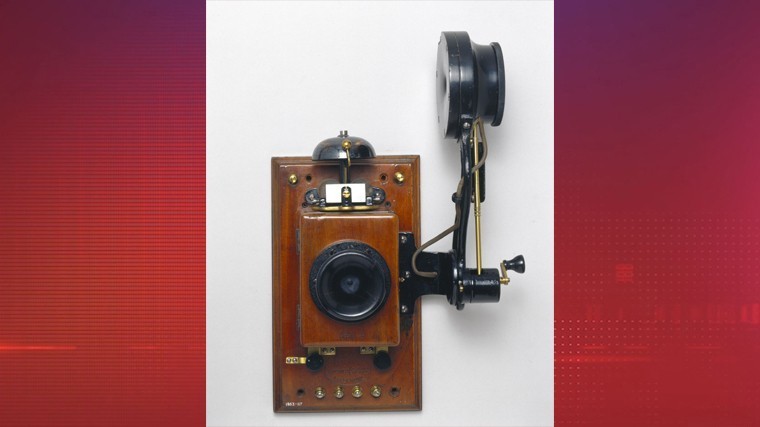 Один из первых телефонов представлял собой тяжелый ящик с имитирующим трубку рычагом. Фото: © Science Museum/globallookpress.com
Один из первых телефонов представлял собой тяжелый ящик с имитирующим трубку рычагом. Фото: © Science Museum/globallookpress.com
К началу XX века телефонные станции обслуживали несколько миллионов абонентов. Человек крутил рычаг с током и так вызывал оператора. Оператор соединял человека с абонентом. После этого можно было начать разговор.
1926–1970: Дисковые телефоны
Появление автоматических телефонных станций (АТС) сократили число телефонисток. Первую станцию в СССР построили в 1926-м в Ростове-на-Дону.
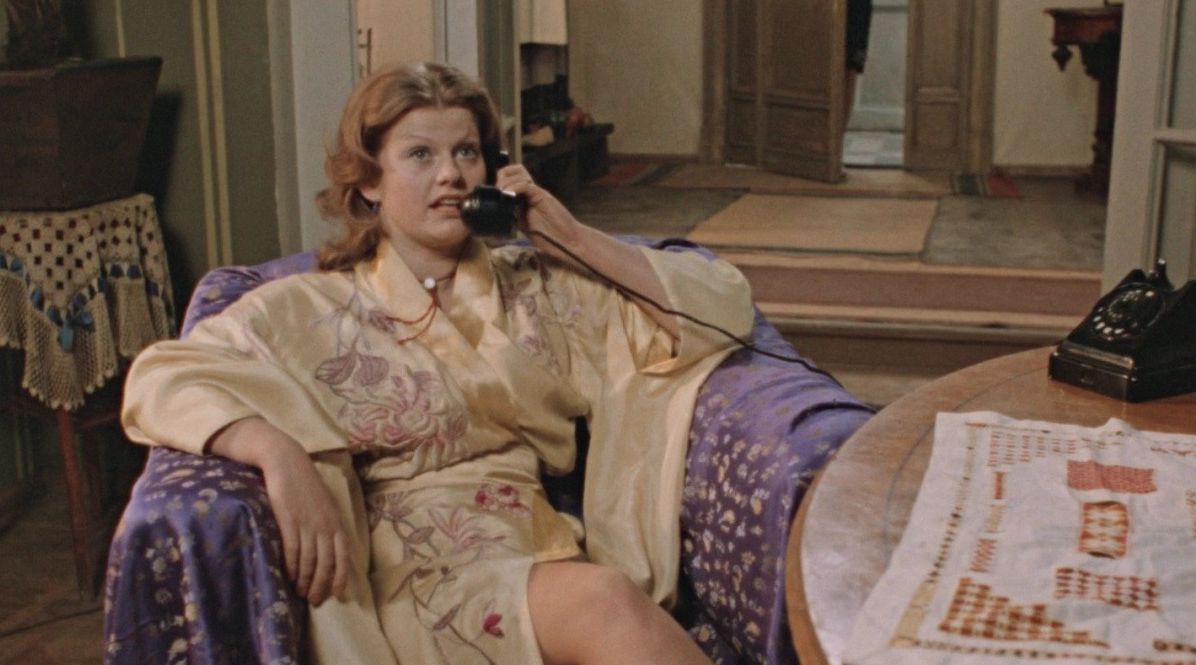 В фильме «Москва слезам не верит» собственный телефон был признаком высокого статуса. Фото: kinopoisk.ru.
В фильме «Москва слезам не верит» собственный телефон был признаком высокого статуса. Фото: kinopoisk.ru.
Телефоны изменились: на аппаратах появился дисковый круг для набора номера. А через несколько лет появились первые телефоны с кнопками. Также изобретатели добавили символы * и # для доступа к дополнительным возможностям.
1973–1990: Первые сотовые
Американский инженер и физик Мартин Купер в 1973-м позвонил по первому в мире сотовому телефону. Тогда телефон напоминал пластиковую коробочку. На доработку аппарата ушло десять лет. Первым сотовым телефоном называют модель Motorola DynaTAC 8000X. Телефон весил около килограмма, работал 35 минут в режиме разговора и стоил более трех с половиной тысяч долларов. Покупатели отмечали, что предпочли телефон равному по стоимости Ford Mustang.
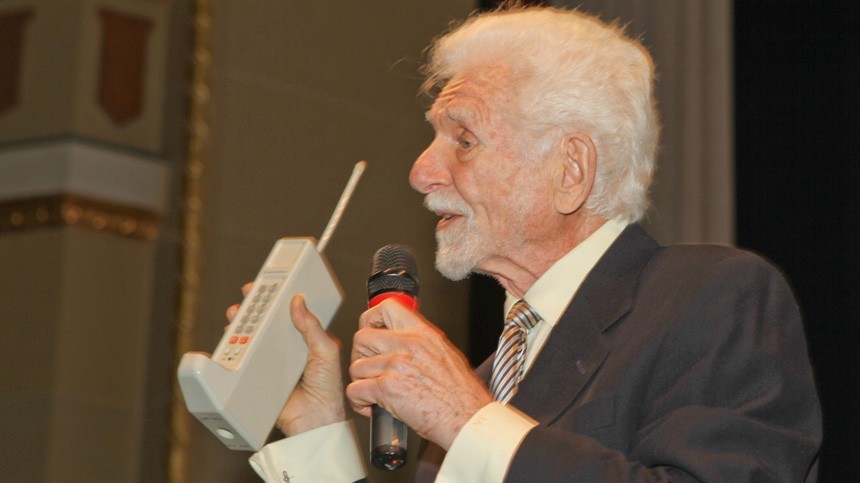 Мартин Купер с первым в мире собственным телефоном. Фото: © Dane Andrew ZUMAPRESS.com/globallookpress.com
Мартин Купер с первым в мире собственным телефоном. Фото: © Dane Andrew ZUMAPRESS.com/globallookpress.com
В России сотовая связь появилась в 1991-м. Лидерами продаж стали финские Nokia. Телефоны весили по три килограмма. Их покупали представители высшего класса общества.
1991–1994: Карманные телефоны
С появлением нового стандарта связи GSM все больше людей смогли позволить себе телефон. Распространение повлияло на модные тенденции: изобретатели уменьшали размеры портативных средств связи, занимались дизайном клавиатуры. Нил Папуорт в 1992-м отправил первую в мире SMS (Short Message Service — Служба коротких сообщений) и поздравил с Рождеством.
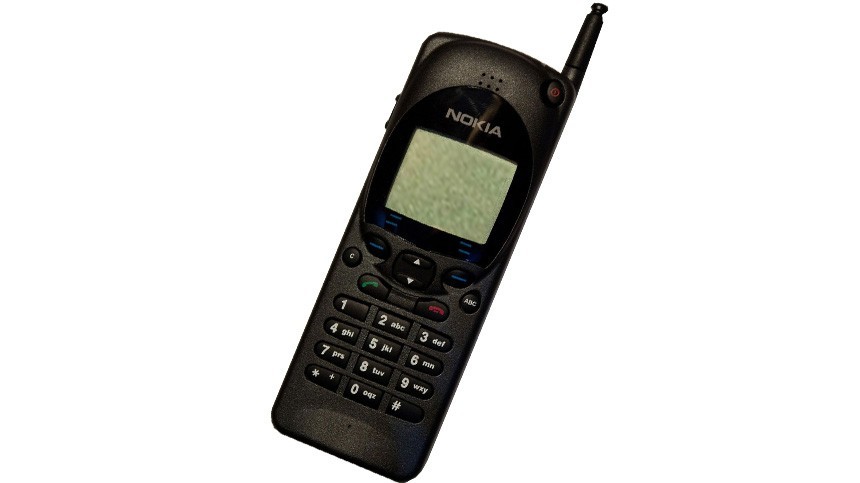
Nokia 2110 — один из первых сотовых телефонов, появившихся в России. Фото: globallookpress.com
Лицом времени в сфере телефонов стал выпущенный в 1994-м Nokia 2110. Покупатели вместе со средством связи получали будильник, калькулятор, секундомер.
1996–2000: Первые «раскладушки»
Изобретатели и техники экспериментировали с формой телефона. Первый в мире телефон-раскладушка Motorola StarTAC стал прорывом среди средств связи. Экран и динамик встроили в верхнюю крышку устройства, а клавиатура и микрофон — в нижнюю. Телефон стал портативным и помещался в карман!
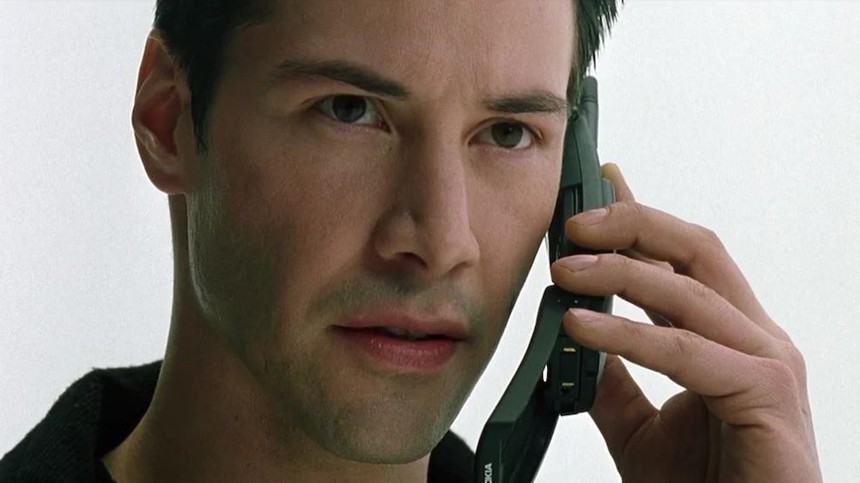 Киану Ривз звонит по сотовому телефону в фильме «Матрица». Фото: kinopoisk.ru
Киану Ривз звонит по сотовому телефону в фильме «Матрица». Фото: kinopoisk.ru
Первый слайдер — Nokia 8110. Устройство из двух раздвигающихся половинок держал Киану Ривз в фильме «Матрица». А вот микс телефона и персонального компьютера Nokia 9000 создали в 1997-м. В телефон встроили раздвигающуюся QWERTY-клавиатуру.
2002–2007: Неубиваемые и стильные сотовые
В нулевые телефоны получили популярность. Между компаниями-производителями началась гонка за покупателей. На рынке появились причудливые формы телефонов. Устройства проигрывали музыку, показывали картинки, выходили в сеть. С добавлением камеры телефоны вступили на рынок фотоаппаратов.
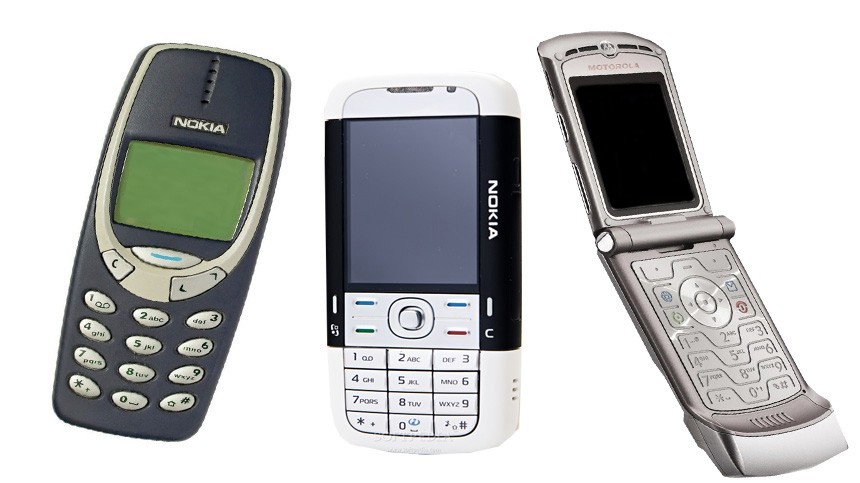 «Неубиваемый» Nokia 3310, Nokia 5700 с функцией прослушивания музыки и «икона стиля» Motorola RAZR V3. Коллаж: 5-tv.ru
«Неубиваемый» Nokia 3310, Nokia 5700 с функцией прослушивания музыки и «икона стиля» Motorola RAZR V3. Коллаж: 5-tv.ru
В 2002-м появился первый смартфон Nokia 9210. Коммуникатор работал в режиме многозадачности благодаря новой операционной системе Symbian OS. Передовые характеристики устройств обеспечивали популярность среди покупателей. Nokia 3310 назвали самым «живучим» телефоном благодаря надежному корпусу. Nokia 5700 стал гибридом телефона и MP3-плеера. А Motorola RAZR V3 назвали «иконой стиля».
2007–2019: Эра смартфонов
К середине «нулевых» первый сенсорный телефон уже продавали, а аппарат с функцией тачскрин (управление пальцами) вошел в обиход. Тем не менее, владелец телефона с сенсорным экраном управлял им с помощью палочки-стилуса или ногтя. В результате на стекле оставались царапины.
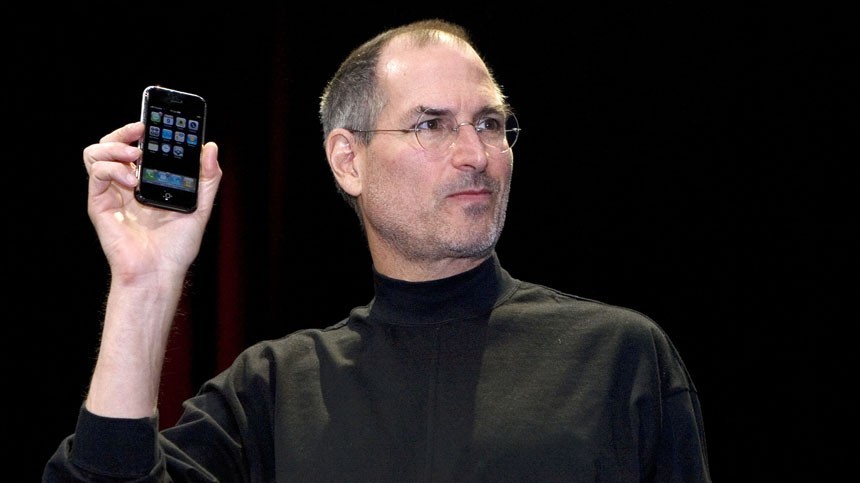 Стив Джобс на презентации компании Apple. Фото: Krista Kennell / ТАСС
Стив Джобс на презентации компании Apple. Фото: Krista Kennell / ТАСС
Стив Джобс на презентации компании Apple в 2007-м показал миру iPhone. Джобс совершил революцию в мире смартфонов и ввел в моду большой экран и минимум кнопок, а все приложения пролистывал пальцем. Популярность iPhone помогла Apple стать первым в мире производителем портативной техники. Самые популярные операционные системы — iOS и Android OS. Владельцы смартфонов платят за покупки с экрана, общаются с друзьями и коллегами, читают новости и смотрят фильмы.
